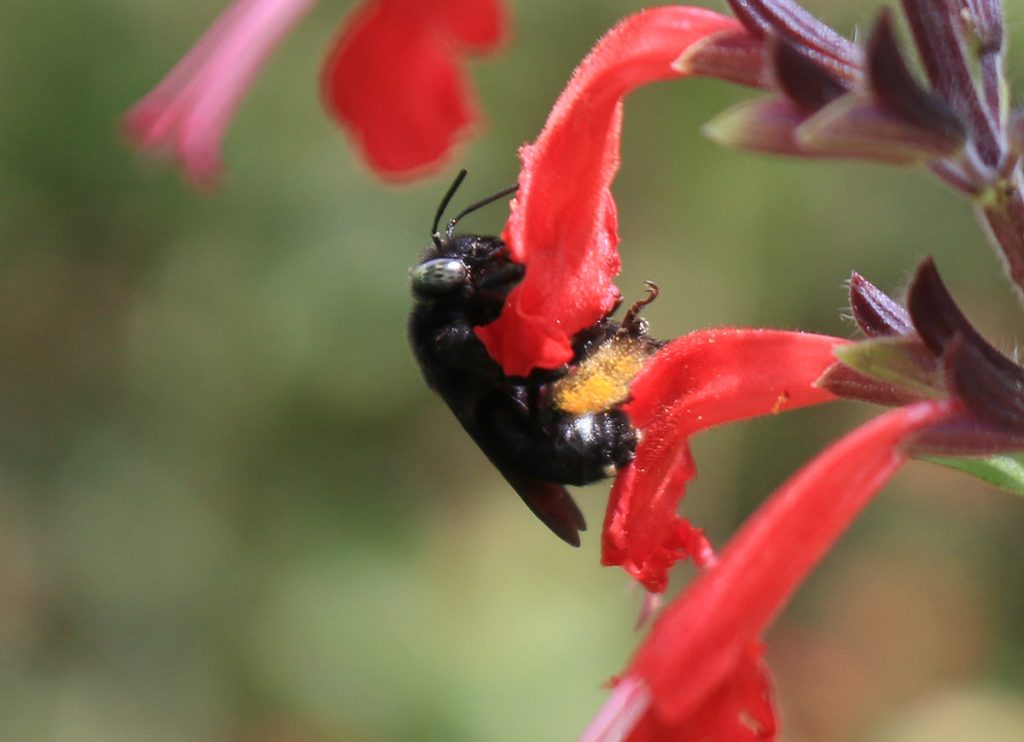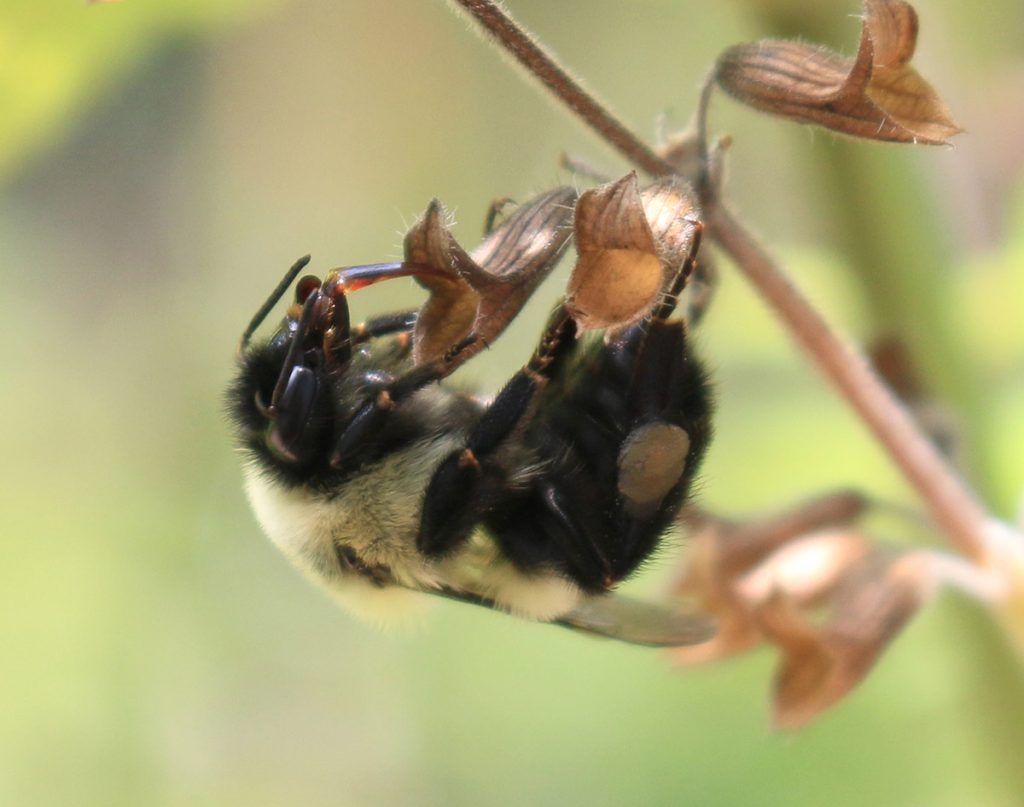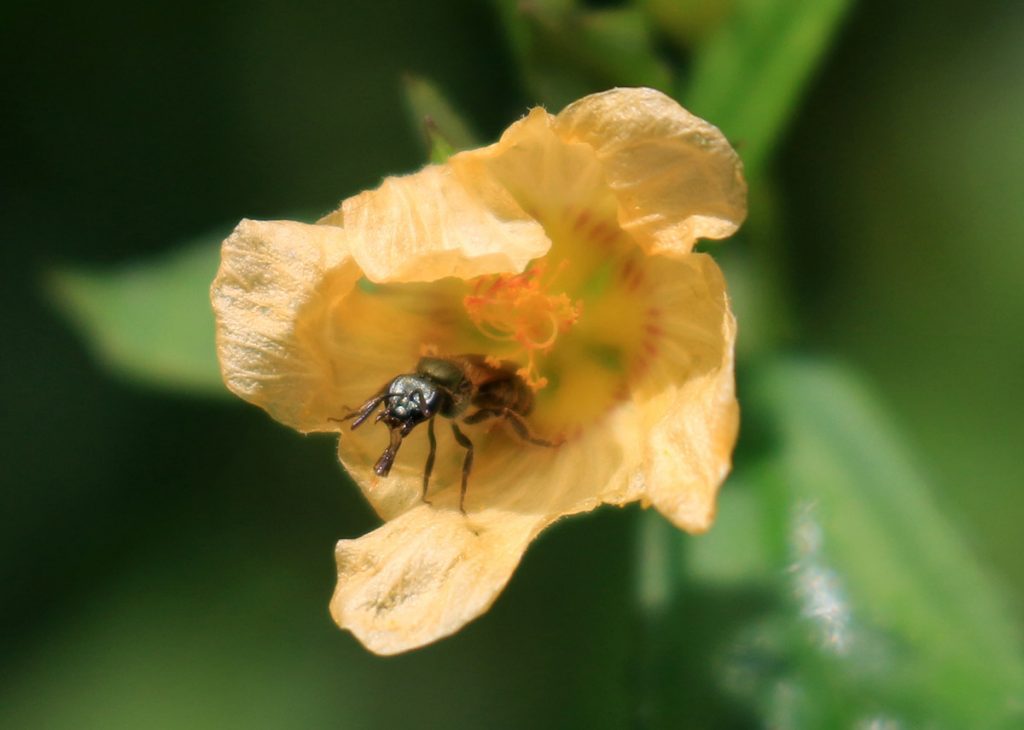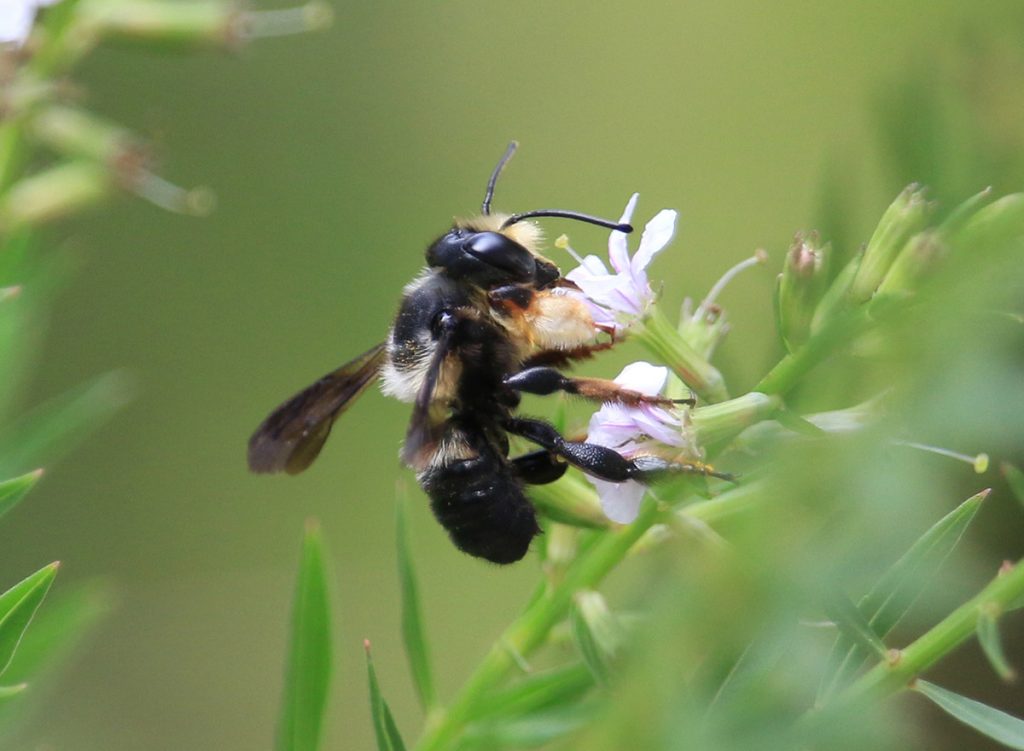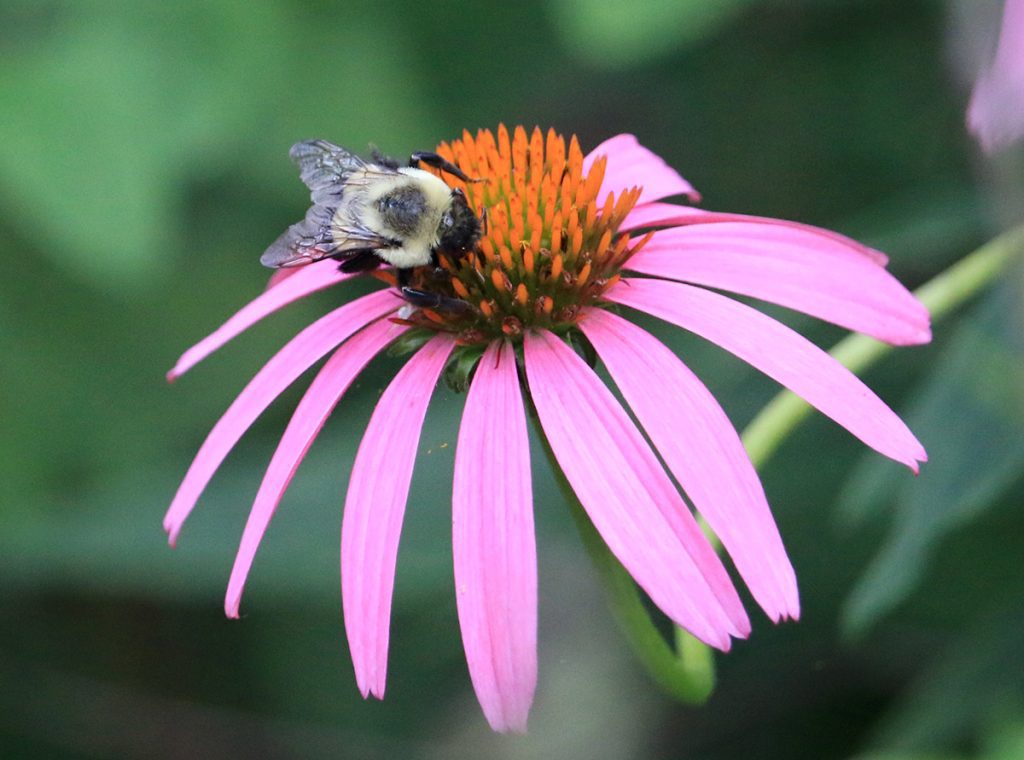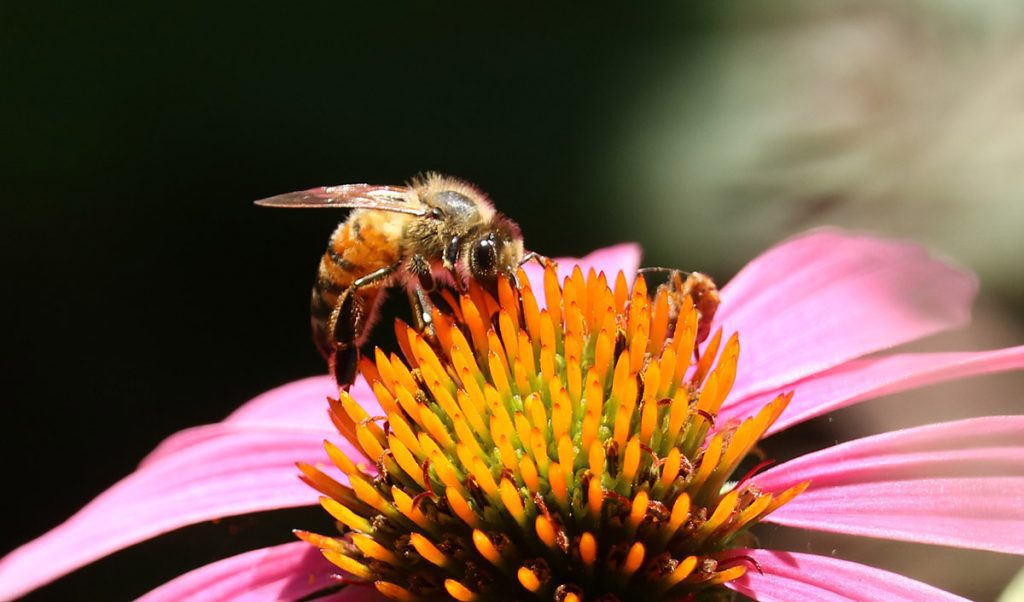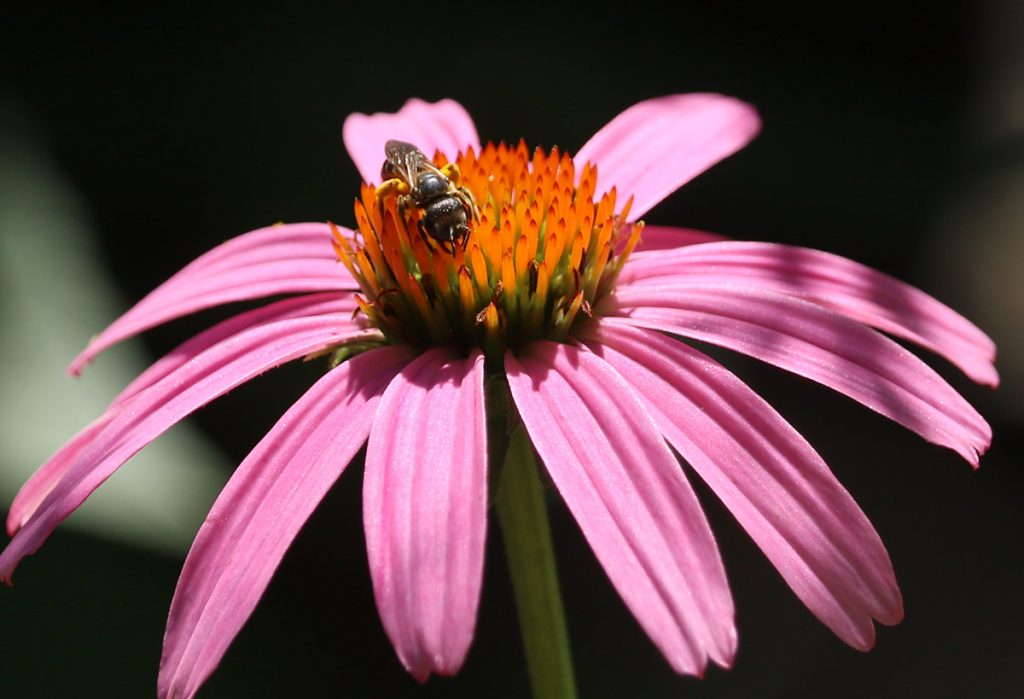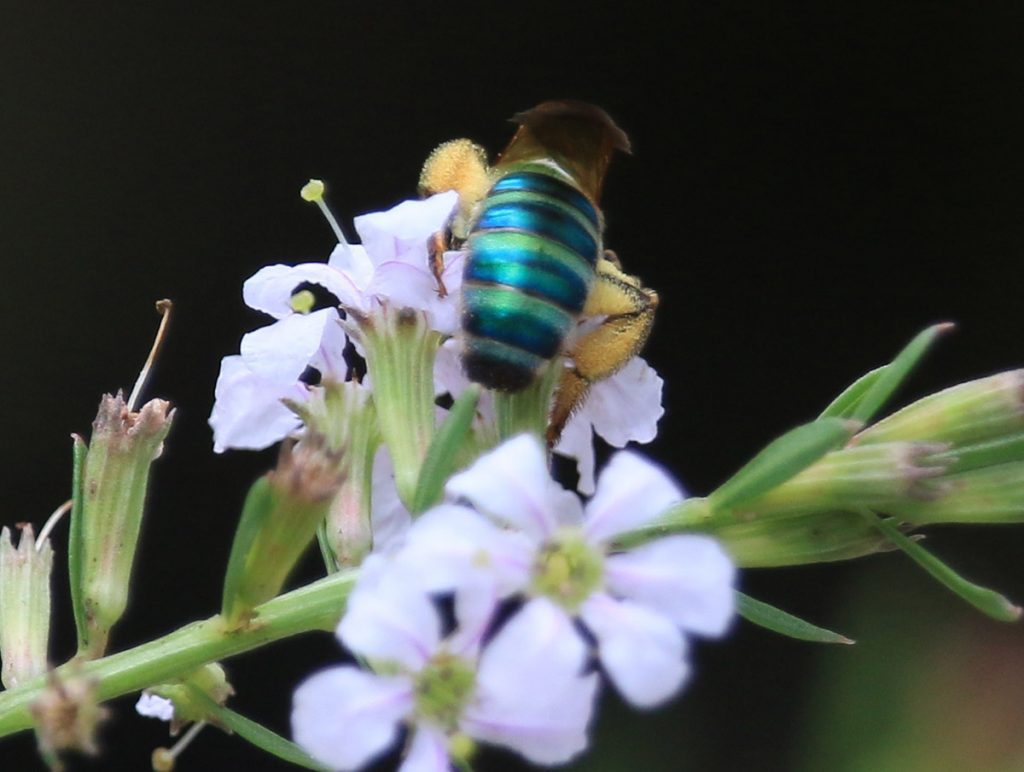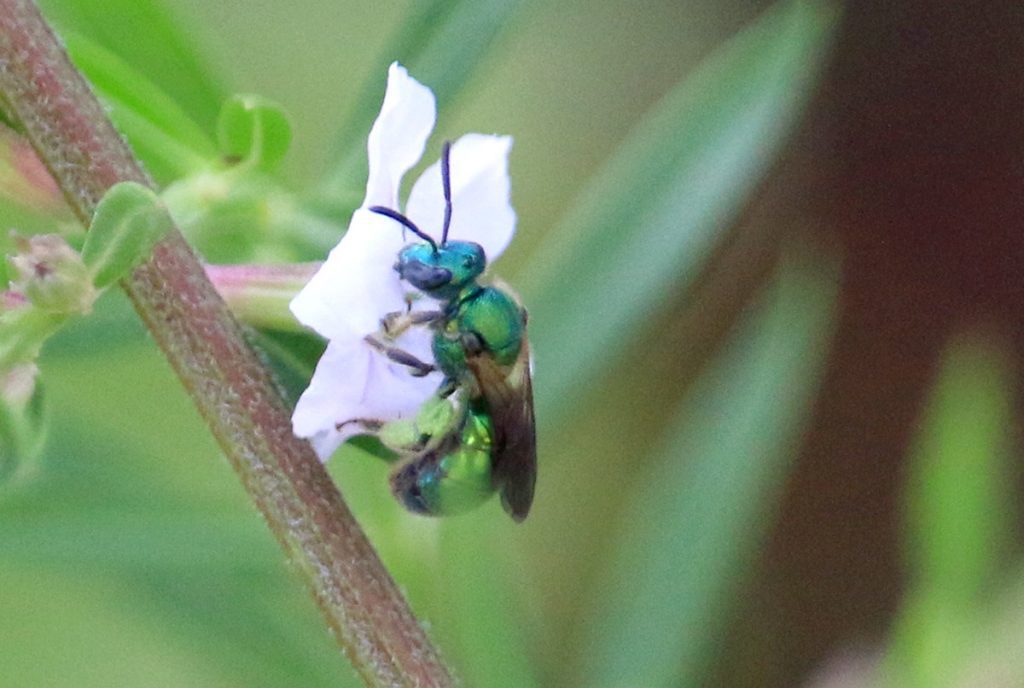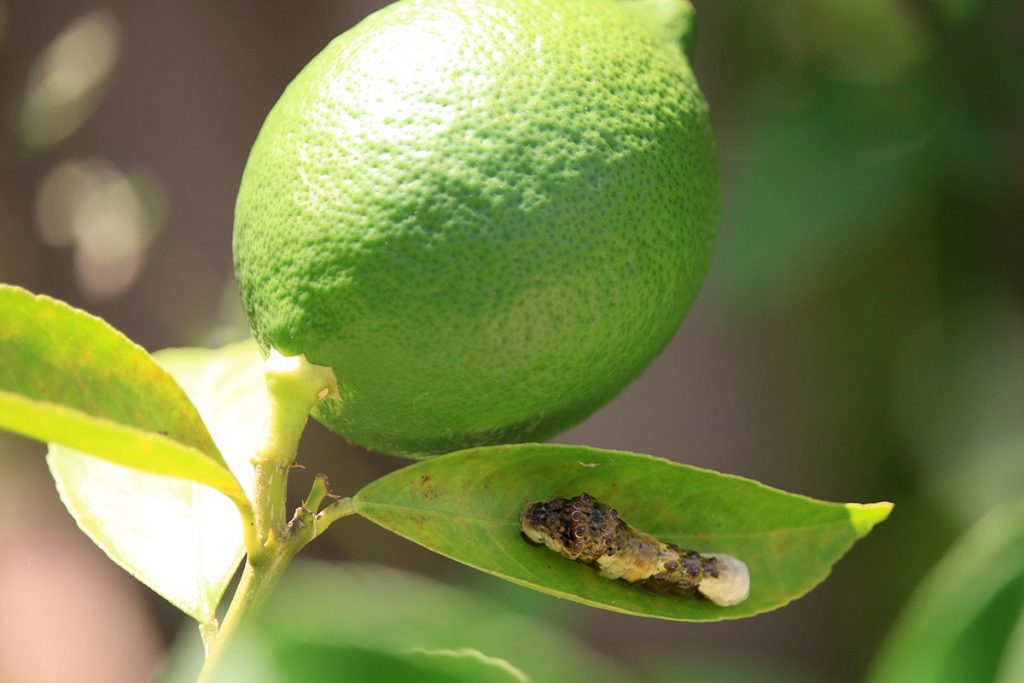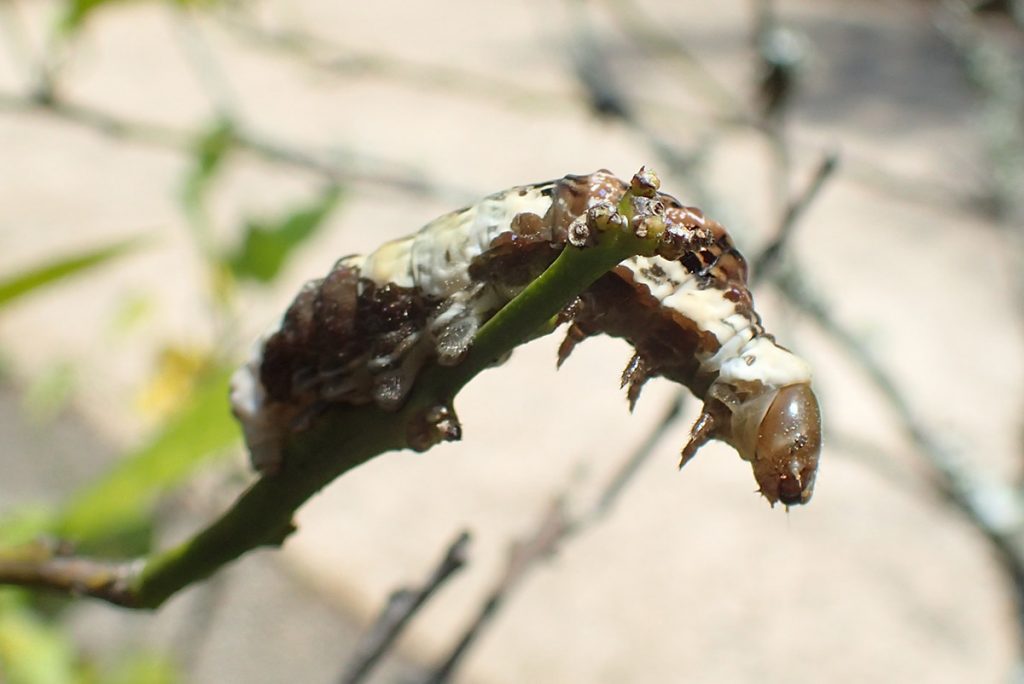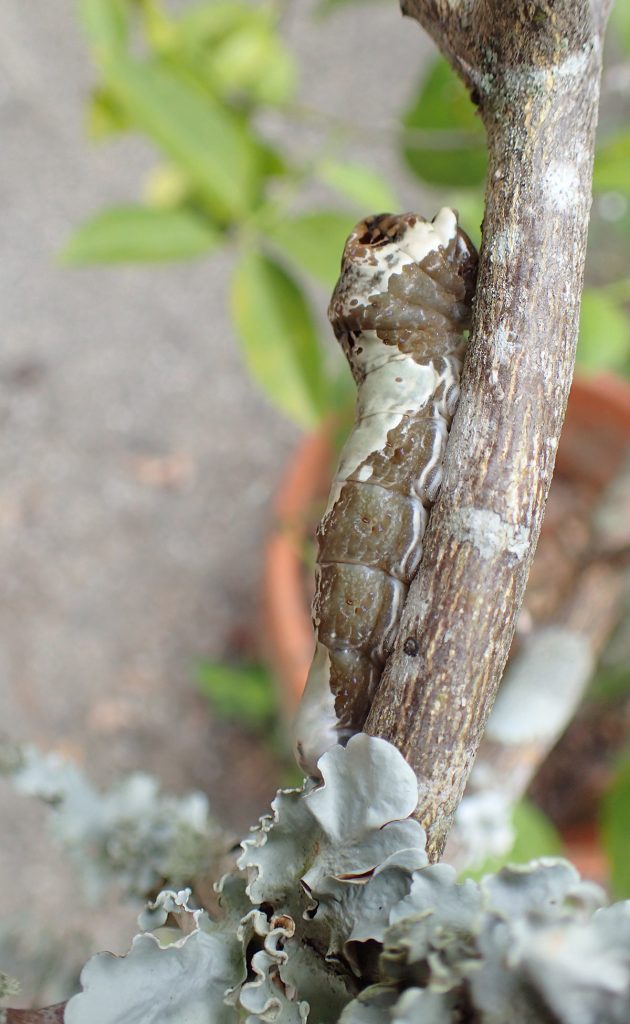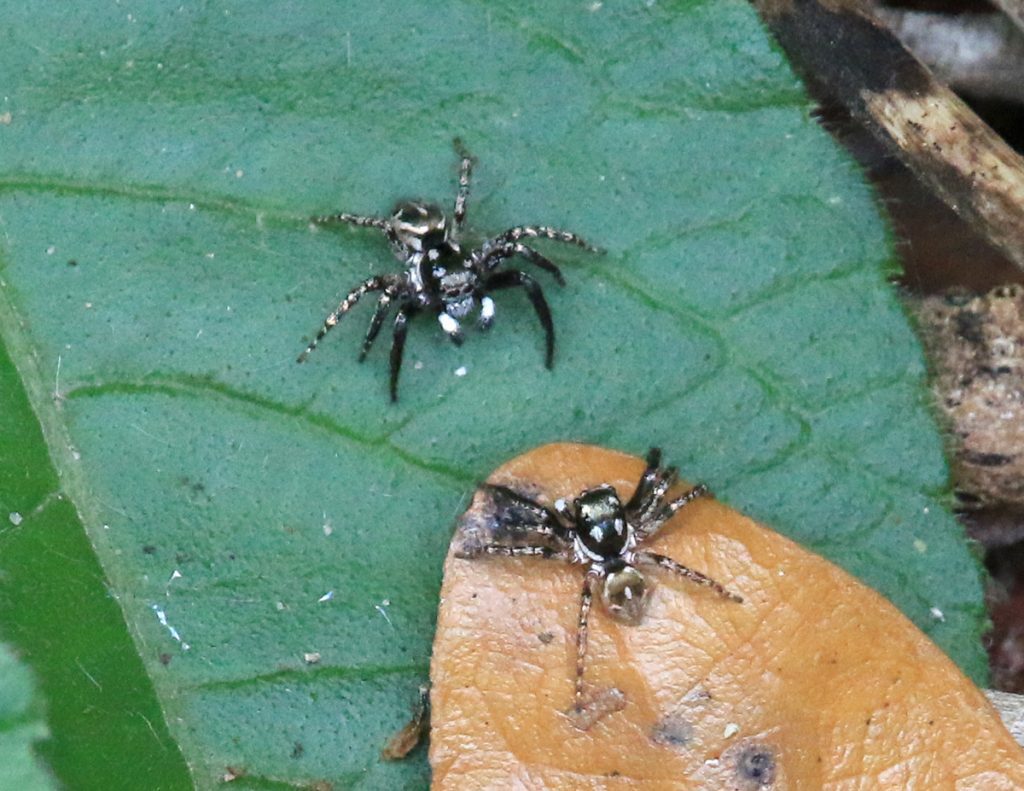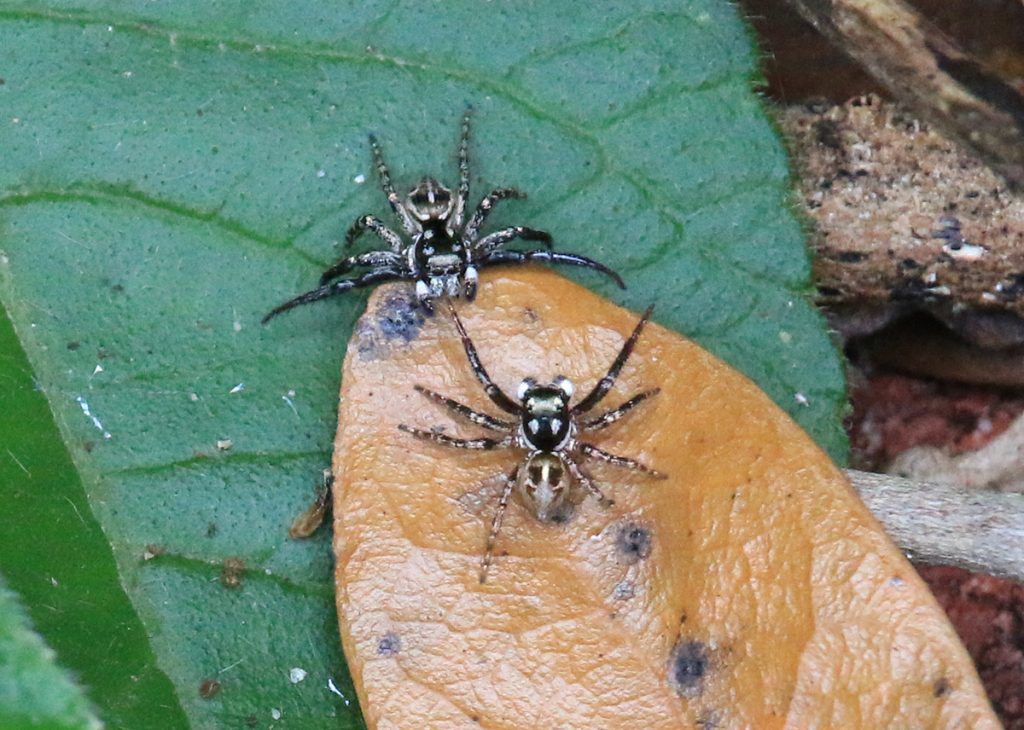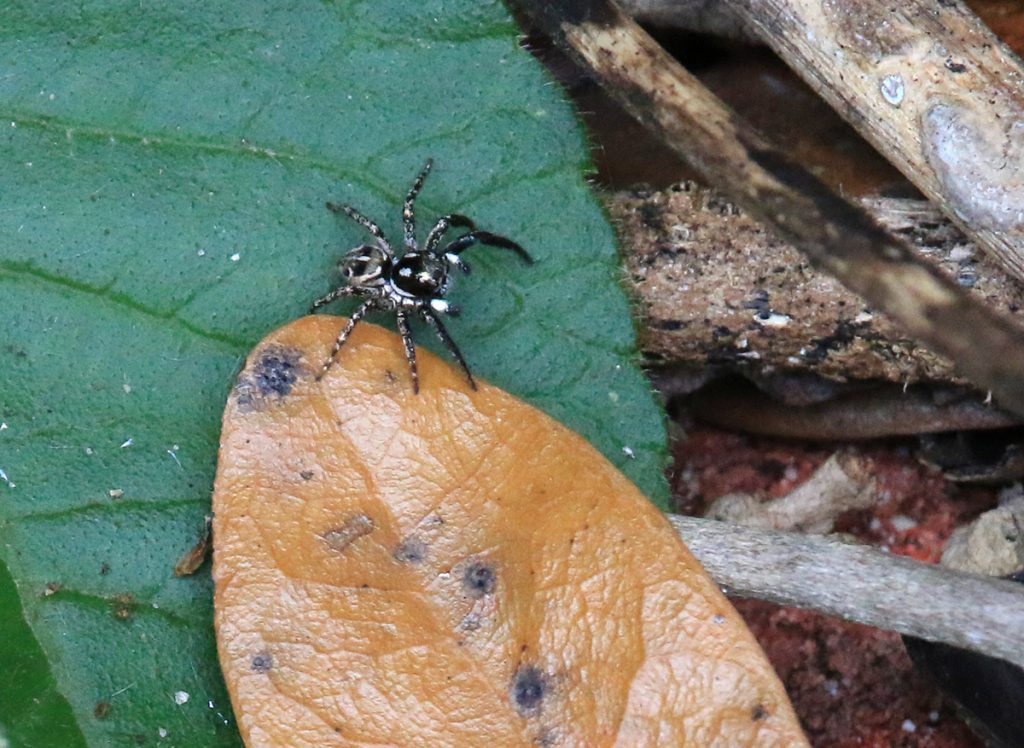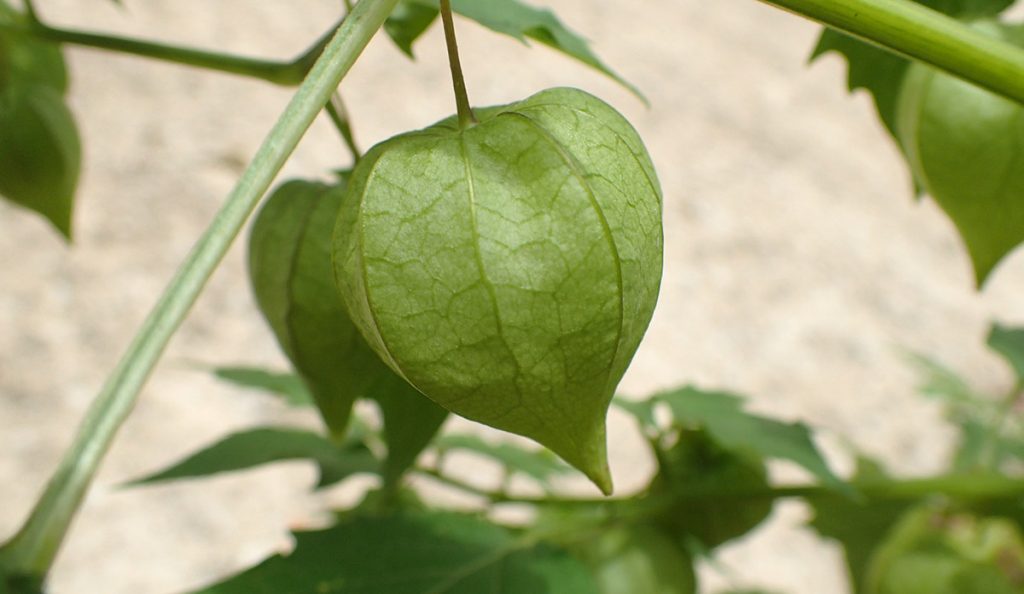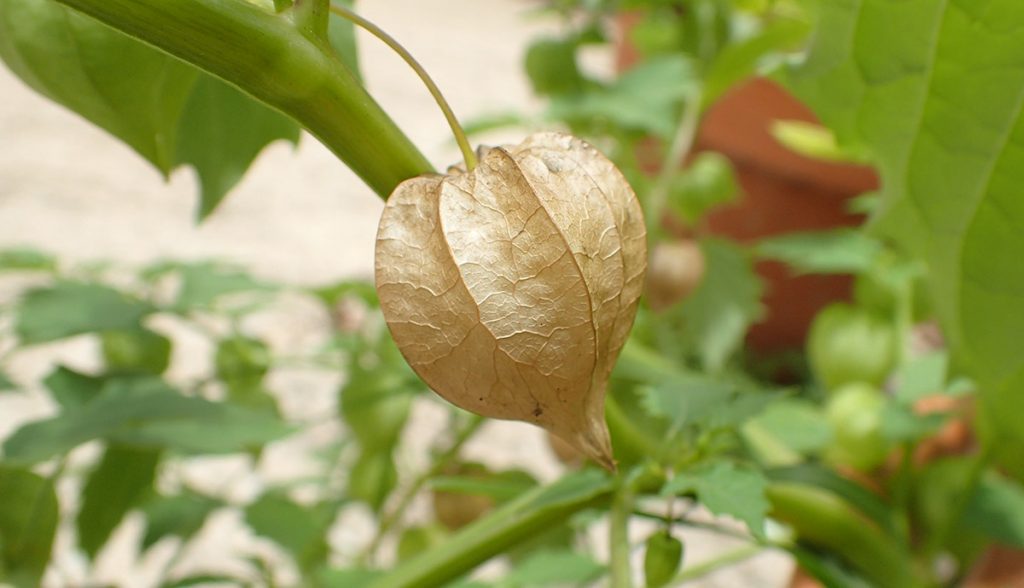I’m starting to wonder about the higher number of pollinators I’m seeing in my yard this year. Is it that I’m working from home, and have more opportunity to see them? Or is it that the garden is finally starting to come together? Let’s just say it’s a little bit of both.
I’m seeing a lot of the same species I’ve seen in previous years, along with a lot of new ones. And not just pollinators, but all of those other lessor known cast members. My eye is always drawn to the flowers, but so much of the action happens under leaves, or in the leaf litter on the ground. Every new species I see further illustrates the biodiversity of my kinda small yard. And I keep noticing new things about our regular residents. The story of our backyard ecosystem is ever unfolding.
I’ve also been wondering about the format of the Backyard Blog posts. We can learn a lot about a species of insect by observing it over time, but all of that information is spread across several posts. It’s a little unwieldy. One thing I’m going to do to address that is create index pages for groups of insects, and one for weeds as well. There’ll be a page for just bees, listing every species I’ve seen in the yard. It’ll have some info on each, and links to the pages where they appear. So if you have a specific curiosity about wasps, planthoppers, butterflies, beetles, and so on, you can start with these pages.
It’ll take me a little while to get them all together. I have my regular ecology stories to produce, and a new grant to work on. You’ll see these pages pop in one by one over the course of a couple of months.
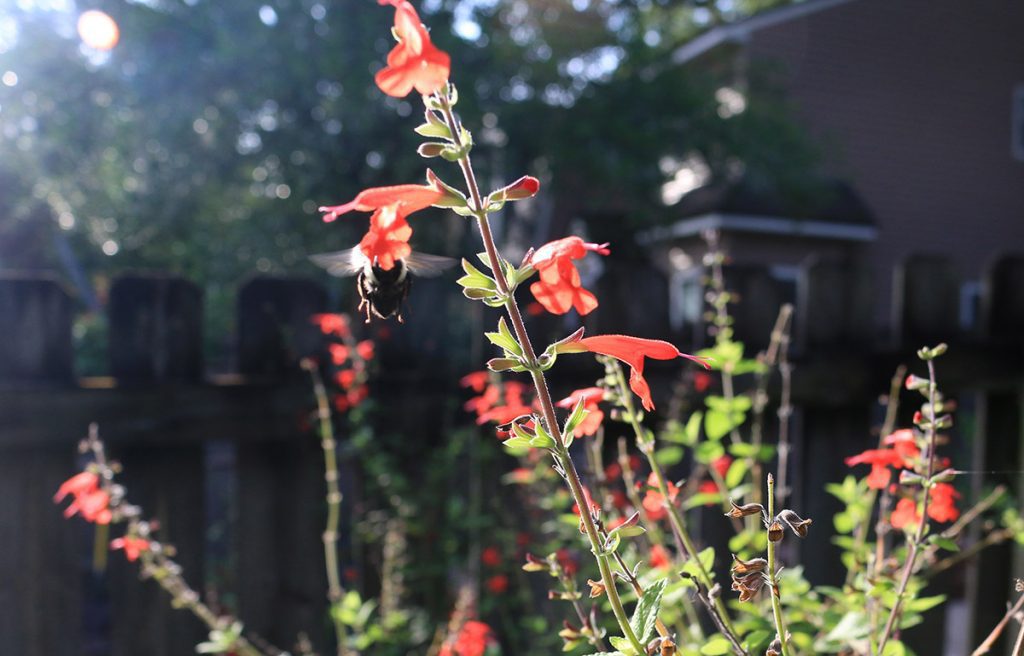
Into the flower patch
When I make my coffee early (sometimes not so early) in the morning, I often look out and see bees already out at work. A couple of years ago, I planted a six by six foot patch of wildflowers, and subsequently let native fanpetals colonize an adjacent area. The red salvia I planted reproduced like crazy, and is growing around the fanpetals. It’s a busy area in the yard.
Bees in the flower patch (returnees)
Early in June, I was seeing the same bee species I’d seen in May, but in greater numbers. As the month wore on, there were more and more of the longhorn bees, maybe 4-5 by the end. Bumblebees peaked at four in mid-June, but they can spread out to multiple points in the yard. So I’m not be seeing them all at once.
There were a couple of new bee species on the year, including one I hadn’t seen here before. I’ll get to those. Quickly, here are the returnees from May:

Two-spotted long-horned bee (Melissodes bimaculatus) on red salvia. 
Eastern bumblebee appears to take pollen from a spent salvia flower. 
A sweat bee in the subgenus Dialictus, peeking out from a fanpetal flower. 
Carpenter-mimic leafcutter bee (Megachile xylocopoides) on winged loosestrife.
The leafcutter bee disappeared by mid-June. This was an interesting insect to watch, as it chased off wasps and flew up to every bee working these flowers.
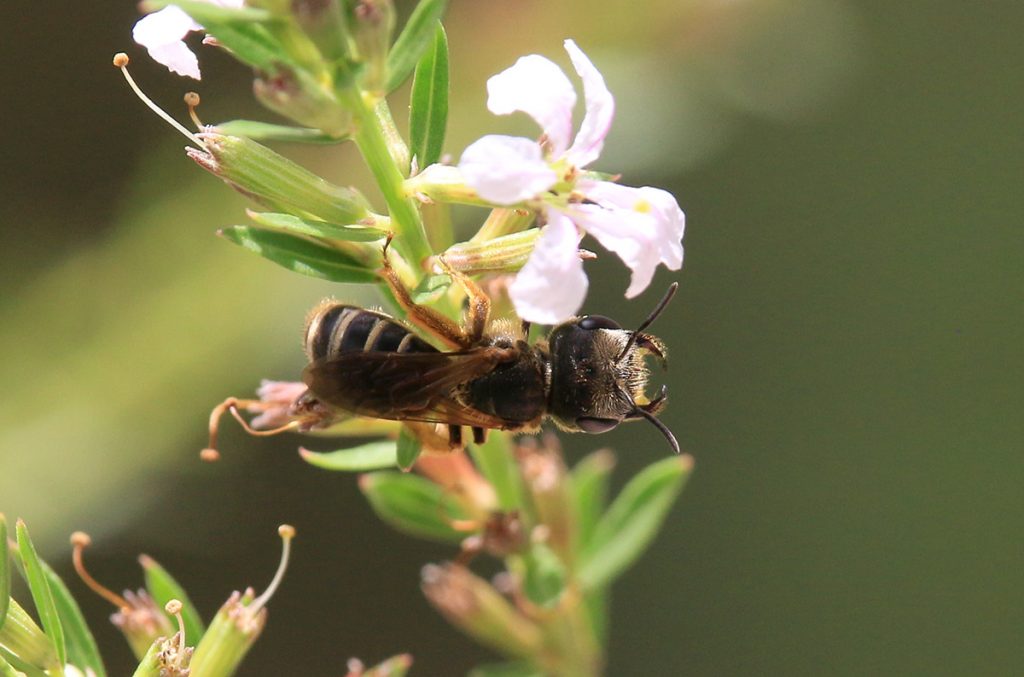
The Poey’s furrow bees had spent May almost exclusively on two different species of coreopsis flowers. Those flowers live in two pots in another part of the yard. During the second week of June, I noticed that one of them would occasionally fly over to the flower patch. I first noticed this after a hard rain, when the coreopsis looked a little ratty.
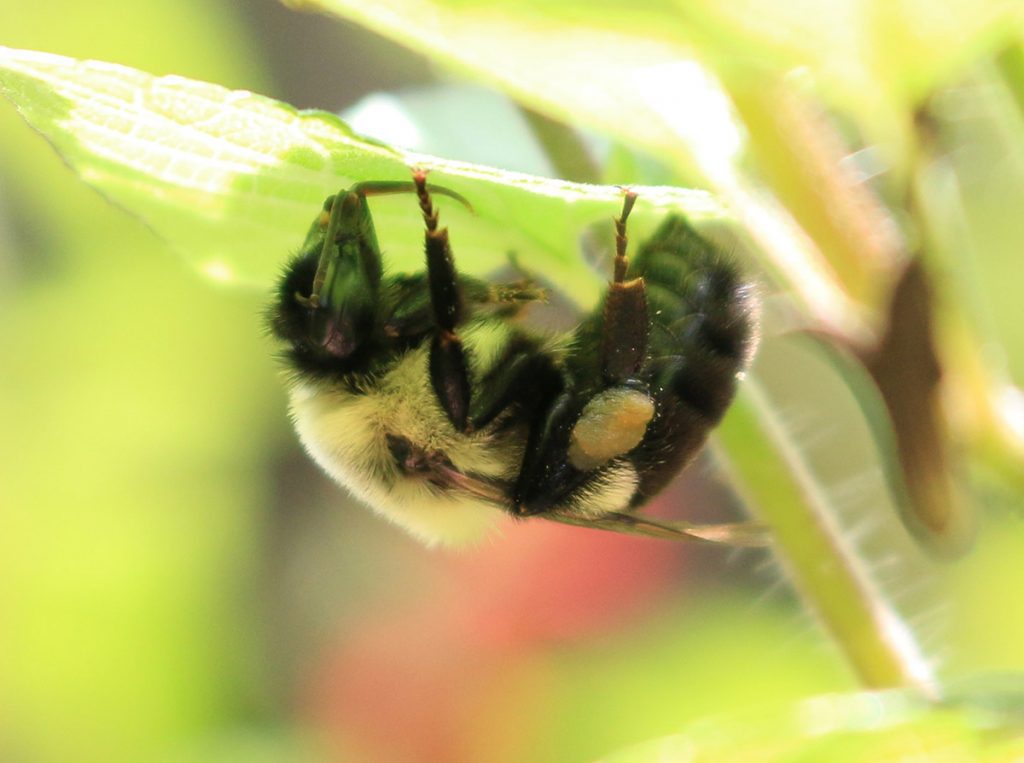
During a busy day in the flower patch, this bumble bee rested under a leaf for a while, with its proboscis out. I wonder what it was doing.
A little action on the purple coneflowers
You’ll notice that most of the action in this patch is on salvia, loosestrife, and fanpetal flowers. We have so many purple coneflowers that look so inviting, to human eyes. They get visited much less frequently than the other flowers, though.

Bumblebee on coneflower 
Honeybee on coneflower 
Poey’s furrow bee on coneflower
Earlier in the year, before many of our flower species had bloomed, we had a few honeybees. They were active on the Ohio spiderwort I let grow everywhere, and they then moved to the cherry laurel blossoms. I still see them every now and then on different flowers, though rarely in this patch. It is a busy place, and not just for bees.
And it does continue to be a busy year for bees. Here are two new species in our yard for this year:
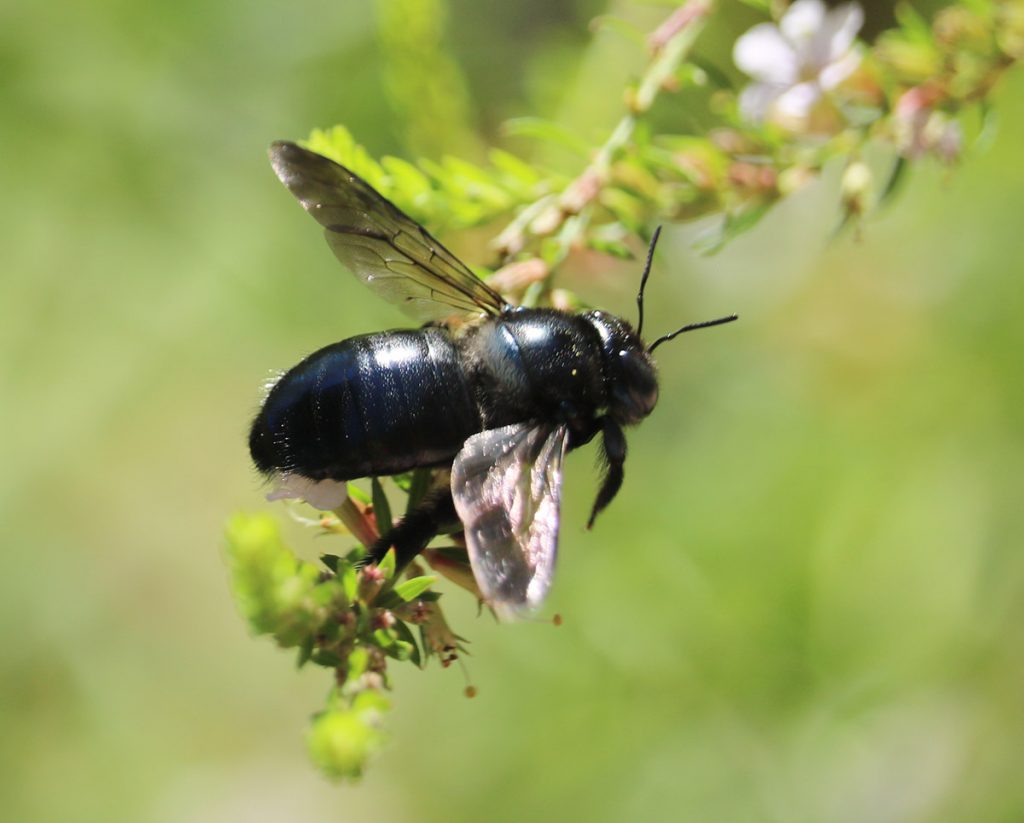
Southern Carpenter Bee (Xylocopa micans)
At first I thought this was another longhorn bee, as those are all black. But look how smooth it is. And it’s big, too. I had a hunch this was a carpenter bee species I’d not seen before. Taking some photos into iNaturalist, I saw that we had two carpenter bee species in our area. I keep seeing eastern carpenter bees in our yard; they have nests in fence posts around the house, though I rarely see (and am able to photograph) them on our flowers.
Clicking compare, I took a closer look at the southern carpenter bee. Most of the photos were similar to the eastern, except one all black bee. I looked it up on bugguide.net and learned that female southern carpenter bees were sometimes relatively hairless.
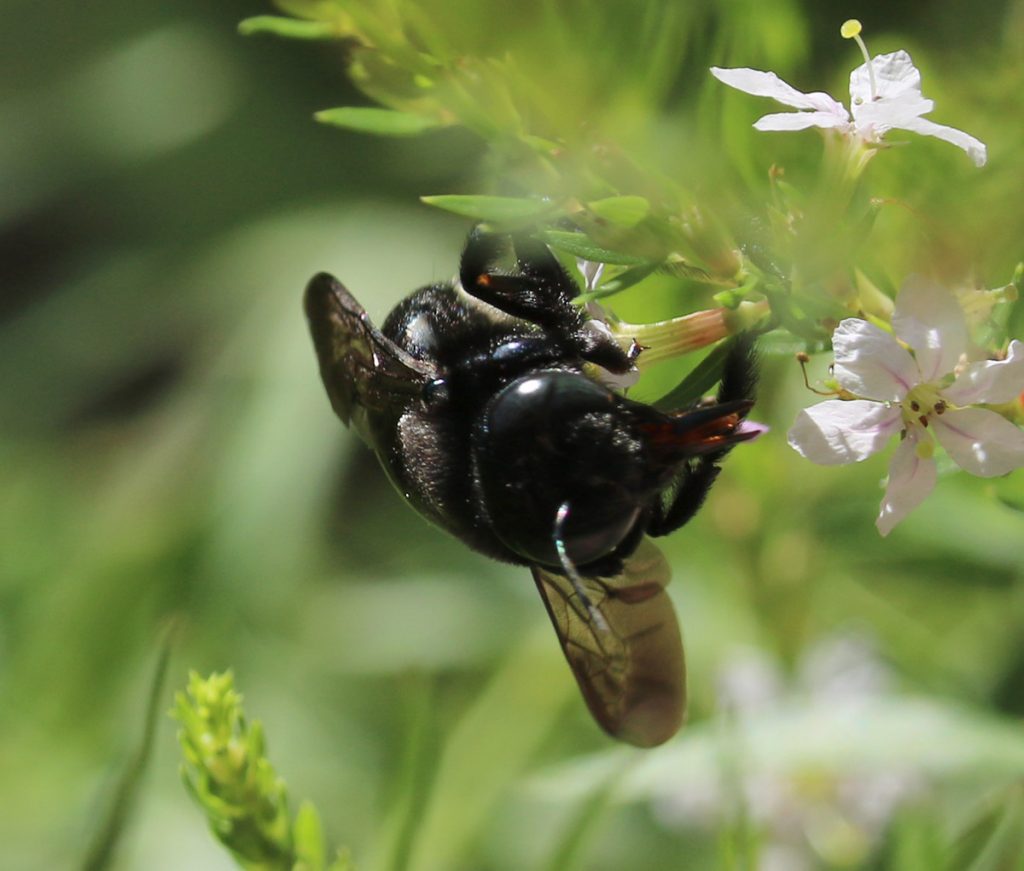
I only saw this in the yard that one day. This is the kind of observation I likely miss out on when I’m out of the house more often. I wonder what else passes through when I’m not looking.
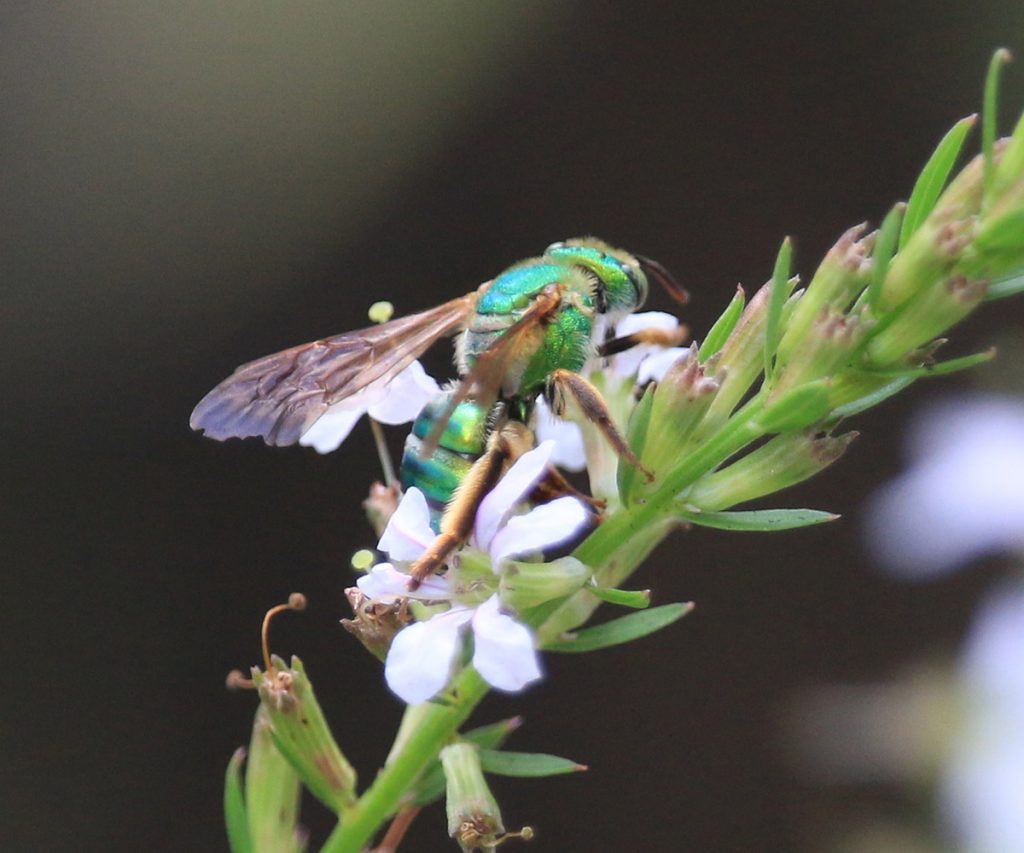
Brown-winged Striped Sweat Bee (Agapostemon splendens)
Here was a challenging ID. Last month, I identified a pure green metallic sweat bee on these very flowers. That bee is very much similar to this one. The stripes on this one’s abdomen tipped me off that this one might be a different species.

Brown-winged striped sweat bee 
Pure green metallic sweat bee
I’ve been seeing the brown-winged striped sweat bee in our yard for years, but those have a greener thorax and a yellow and black striped abdomen. But I had noticed on iNaturalist that some of their photos showed what looked like green sweat bees. These are the females. Notice the pronounced striping on the brown-winged. Also, pure green sweat bees have wings that aren’t as brown, and are clearer looking:
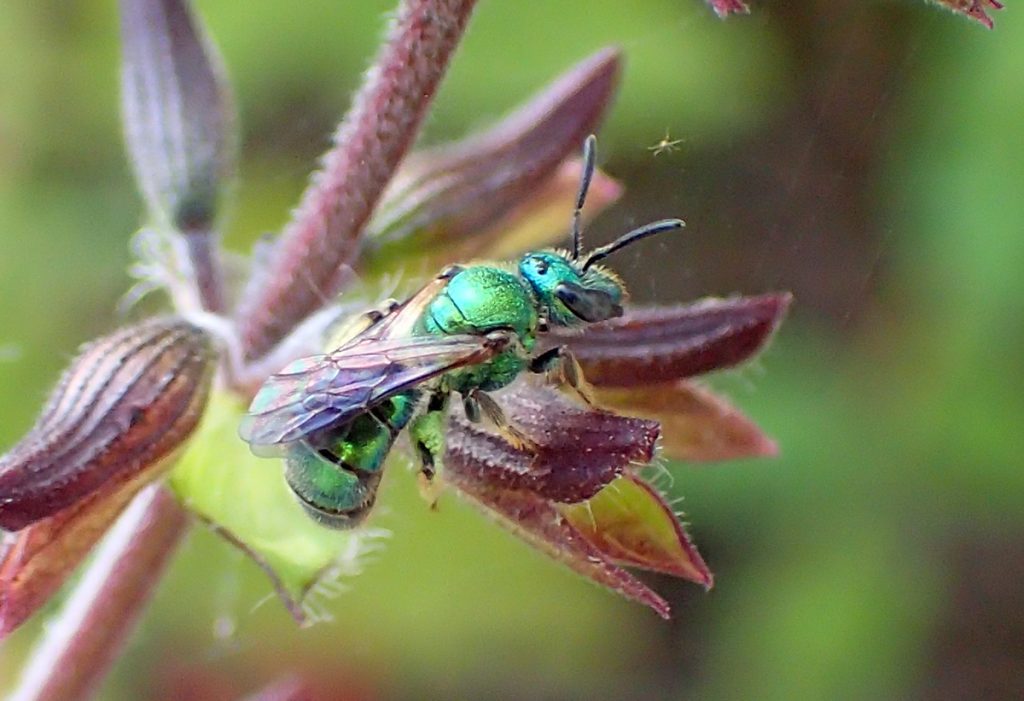
If you enjoy staring at wings and thoraxes and head shapes and slight differences in coloration, you might enjoy amateur entomology. Anyhow, here is the male of the species, which were very much present in the yard last August:
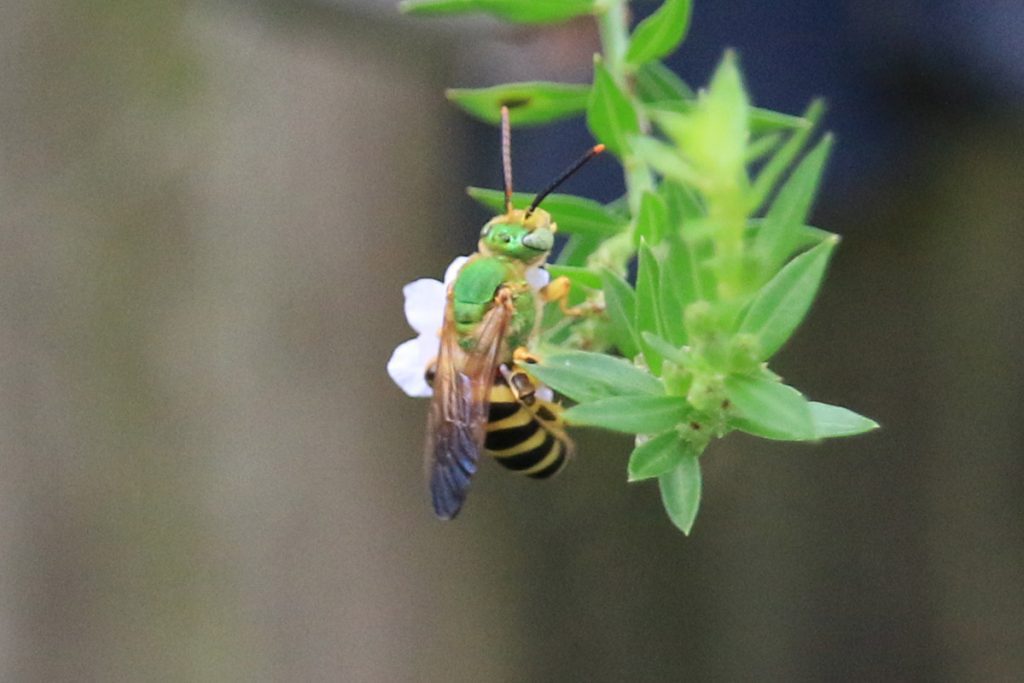
Before I move on from bees, I want to share one more photo. My younger son received pumpkin seeds from his school that we planted in March. And I love it when bees pollinate squash flowers:
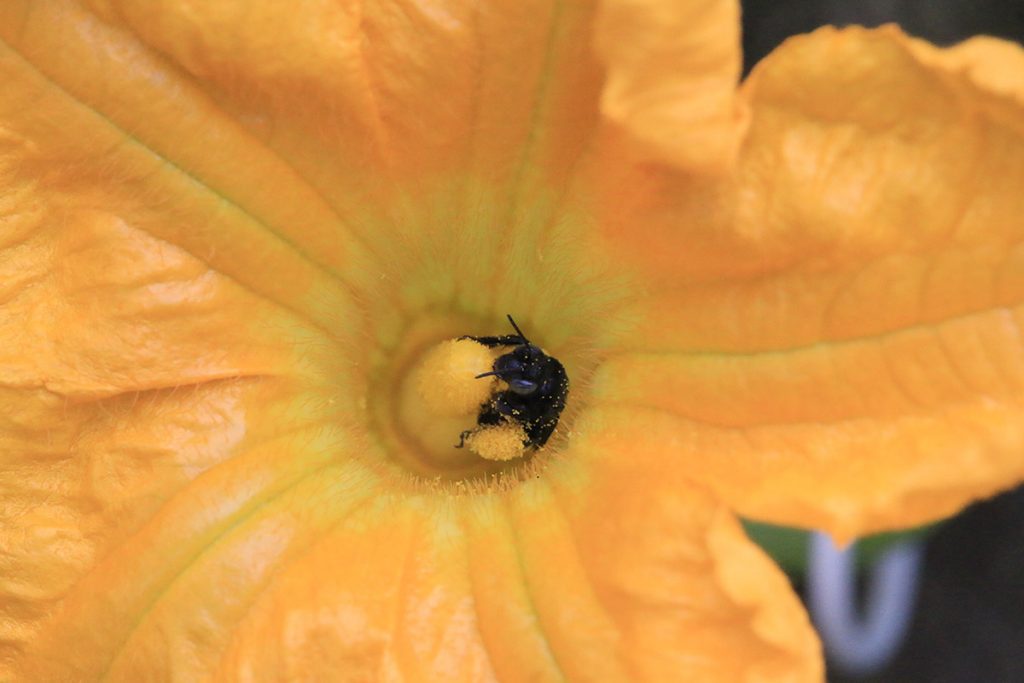
Butterflies in the flower patch
We had an explosion of butterflies in early May, but some hard rains have knocked a lot of flowers off the lantana bed where I’d been seeing them. So while we still see butterflies, they’re competing with bees and wasps for time on the other flowers. It seems like a few years back, we had more butterflies and less bees and wasps in the yard. But then every year is different, and possibly for reasons that have nothing directly to do with my yard.
Clouded skipper (Lerema accius)
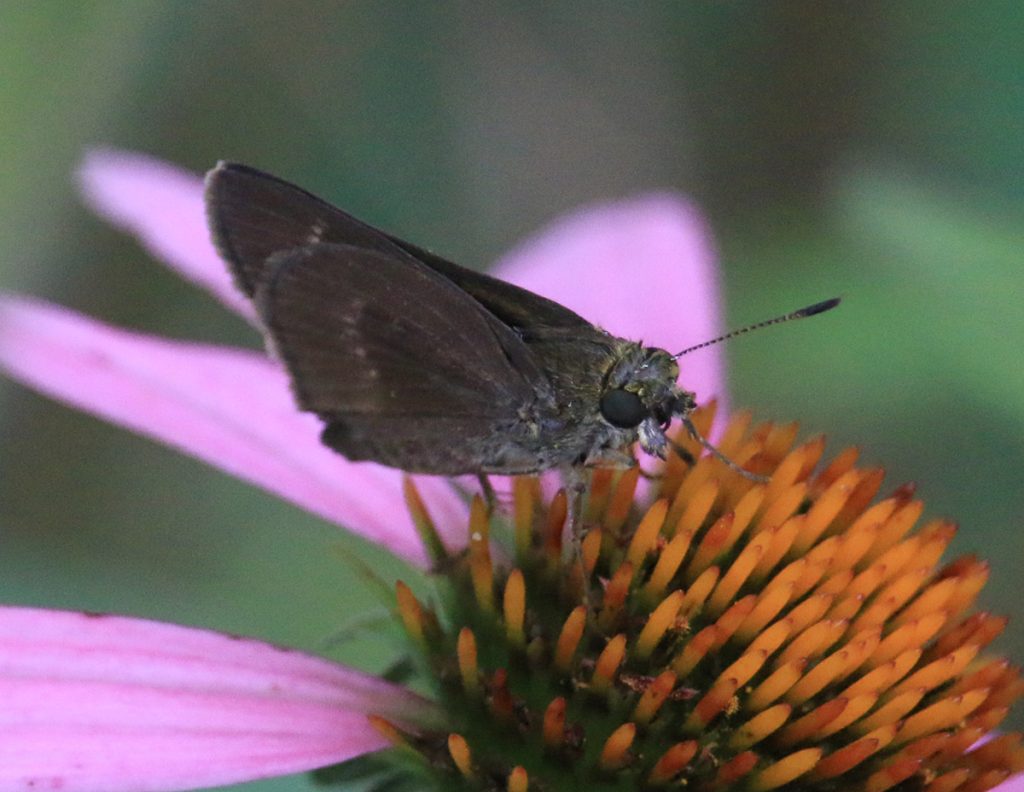
This is one of those butterflies that, maybe I saw it for the first time in June this year. Or maybe this small, brown, nondescript skipper was flying around with the Horace’s duskywings and other brown butterflies of the yard, and went unnoticed. However, I did see it on a couple of different occasions.
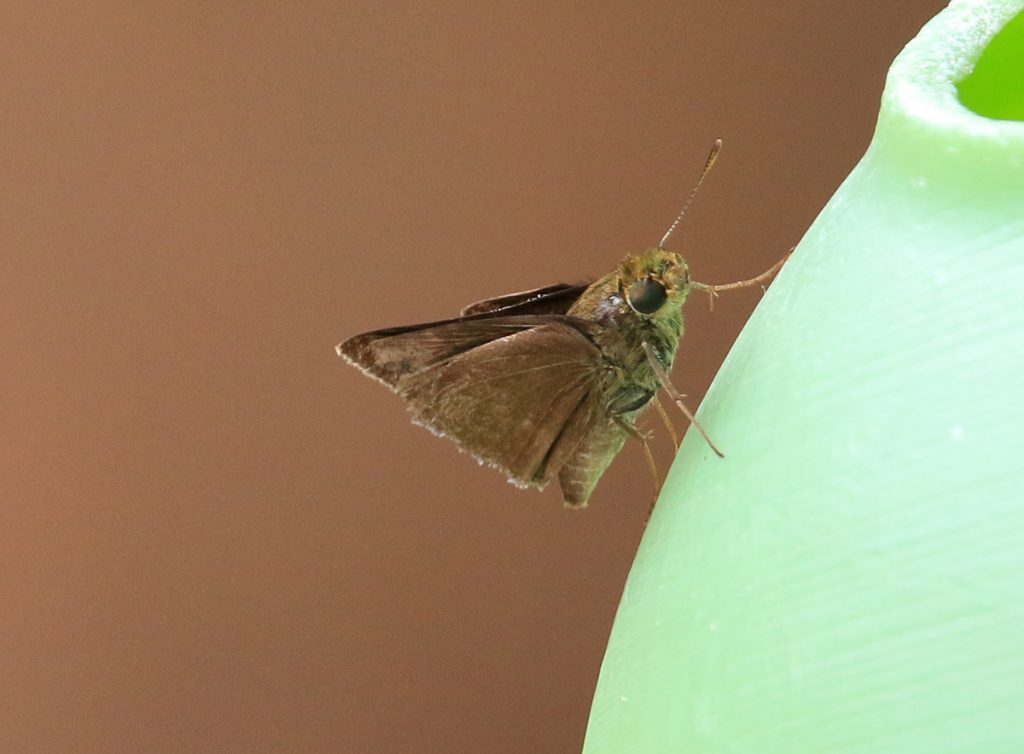
This butterfly hosts on grasses.
Zebra longwing (Heliconius charithonia)
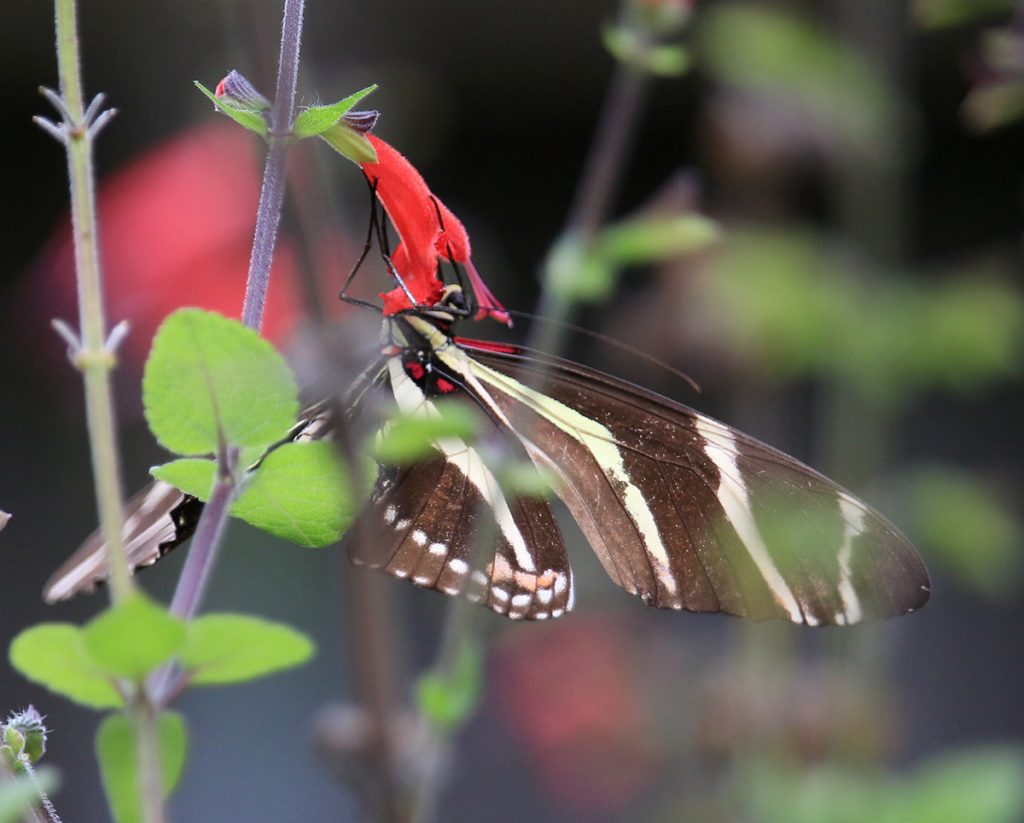
After a couple of years of not seeing them as often, zebra longwings seem to be back. One or two seem to pass by once or twice a day and spend some time in the flower patch. And then, one night at the end of June:
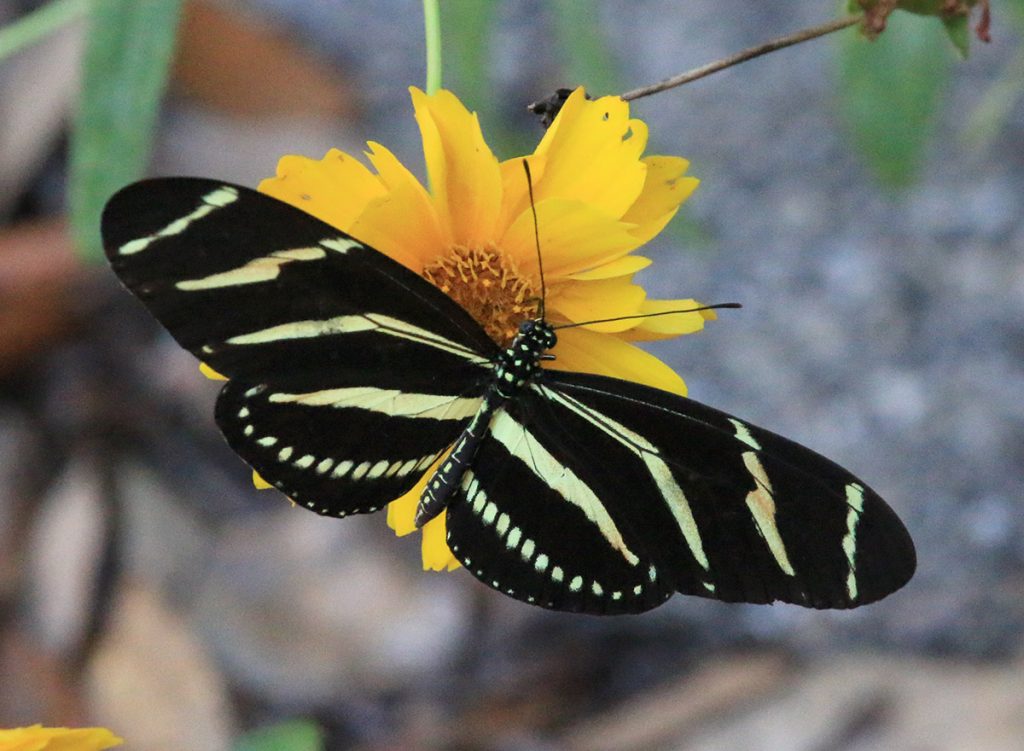
Just the night before, two Poey’s furrow bees were sleeping on this flower. That night, though, this butterfly spent quite a lot of time here. I went in and out the back door, and kept seeing this butterfly on this flower. Most of the flower plants in the yard have numerous small blooms, and pollinators move quickly from one flower to the next. The Poey’s bees spend some time on this flower, as have the longhorn bees.
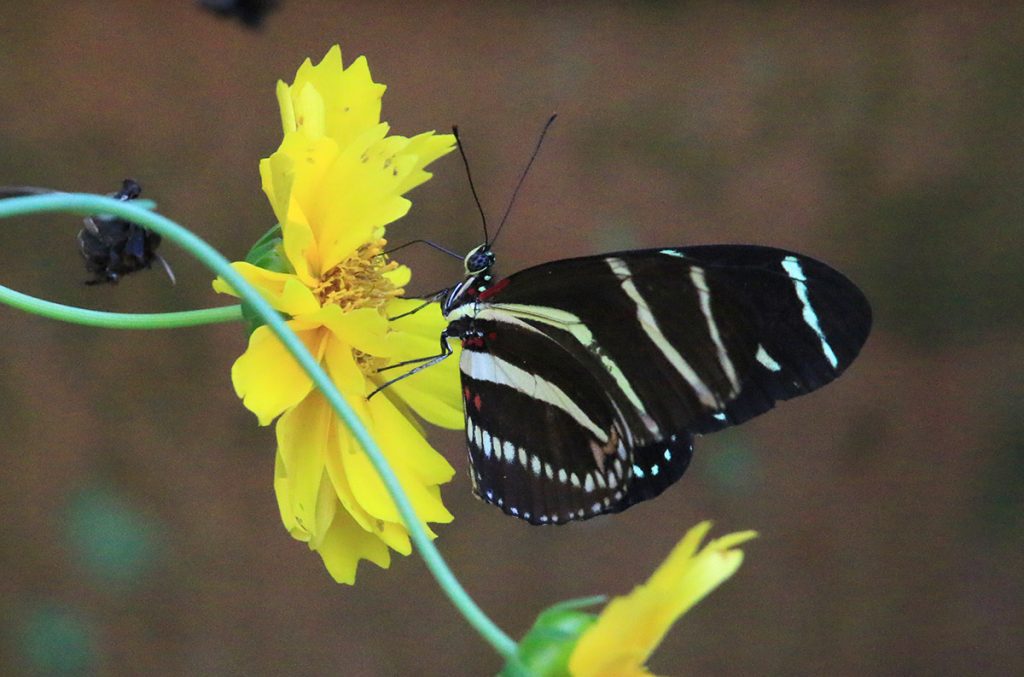
You try not to project human characteristics onto animals, but it felt like, after a long day of fluttering about and hopping flower to flower, this butterfly wanted to sit and eat in peace for a while.
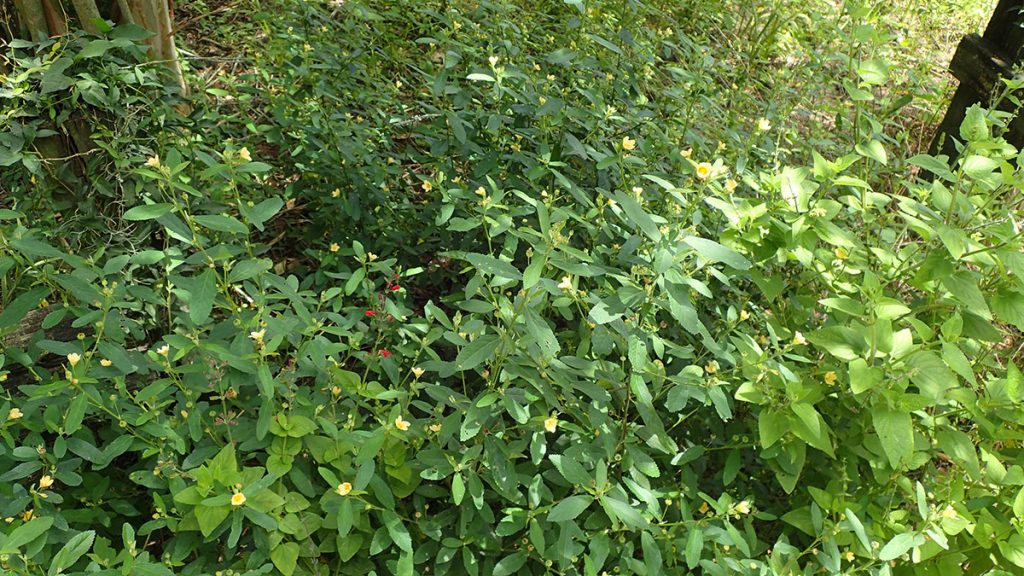
Into the fanpetal patch
I have a couple of butterfly photos in this section of the flower patch, but also just a ton of other insects. Many were plant eaters, while others might have been predators. Some I looked up and read that they were considered major pests. I don’t see many of these insects outside of this dense patch of vegetation. And maybe I’d feel differently about stinkbugs if they were all over my tomato plants.
And then there’s this:
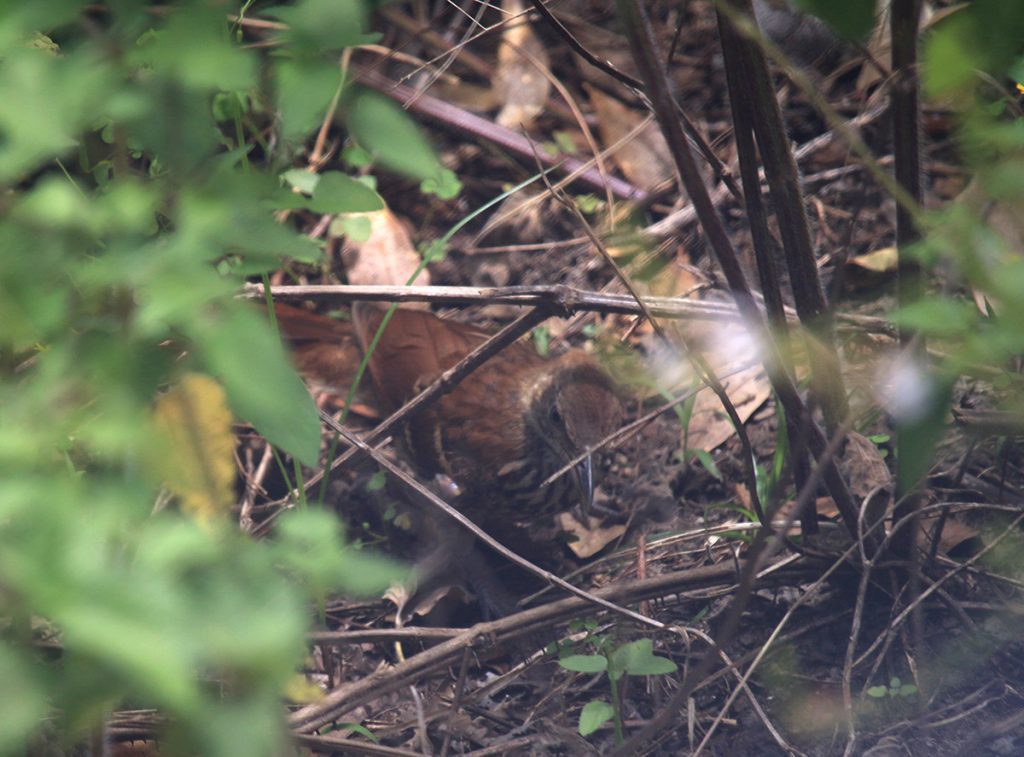
This is a brown thrasher fledgeling. I’ve also seen cardinal and Carolina wren fledgelings foraging in this area. It’s full of food for them. I keep repeating it, but I think this is an important point. If you don’t have an outbreak of any one particular insect, let them be. The animals in your yard need them. Plants take light from the sun and turn it into energy, and that energy gets to all animals through the plant eaters.
Plant eaters in the fanpetals
So who are these pests?
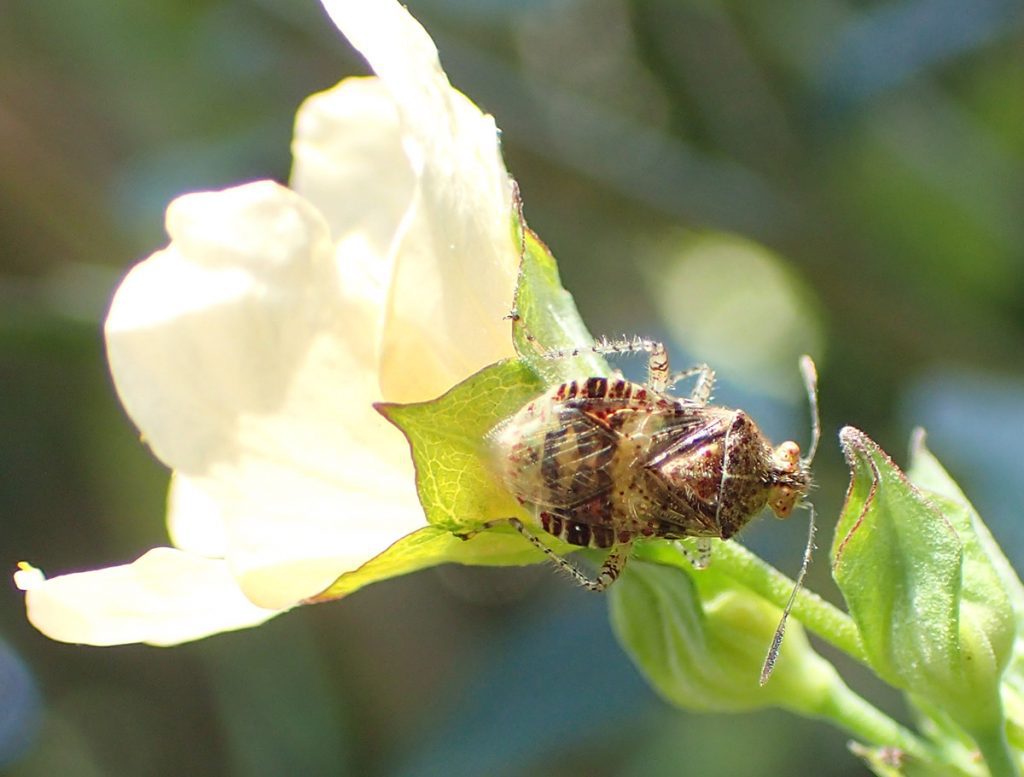
Here’s another one of those insects with no common name. On Bugguide, I read that Niesthrea louisianica feeds on flowers and buds of plants in the Malvaceae family, to which fanpetals belong.
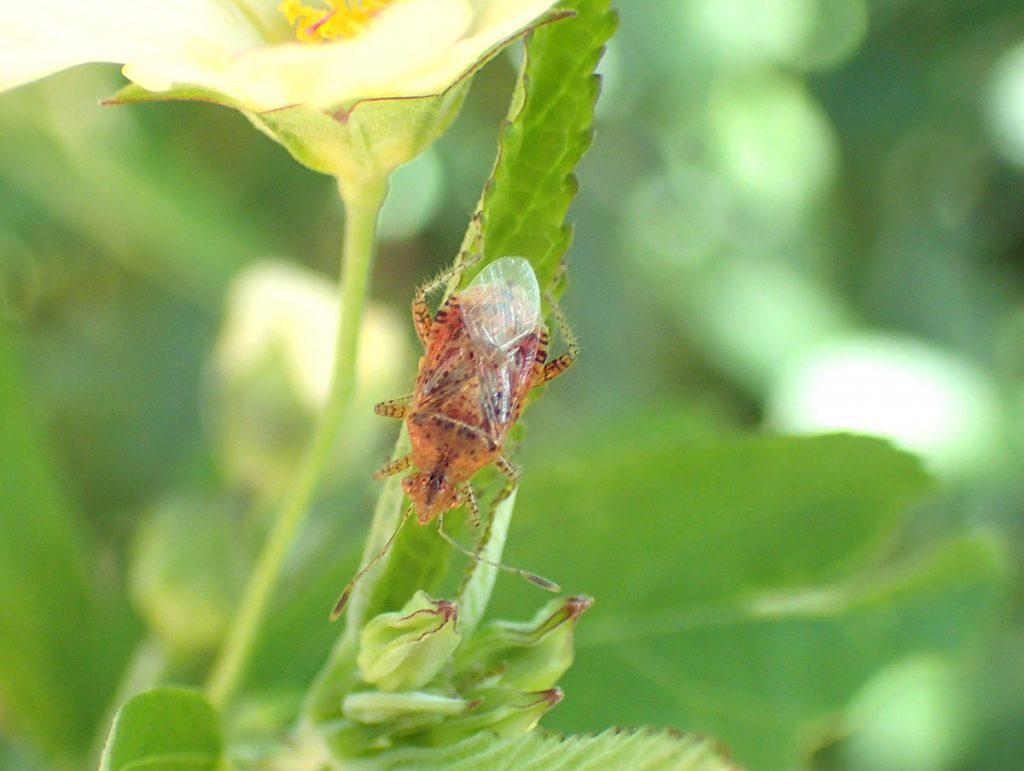
It’s a type of scentless bug, as opposed to a stinkbug. But it’s eating our fanpetals nonetheless. I think this is its nymph:
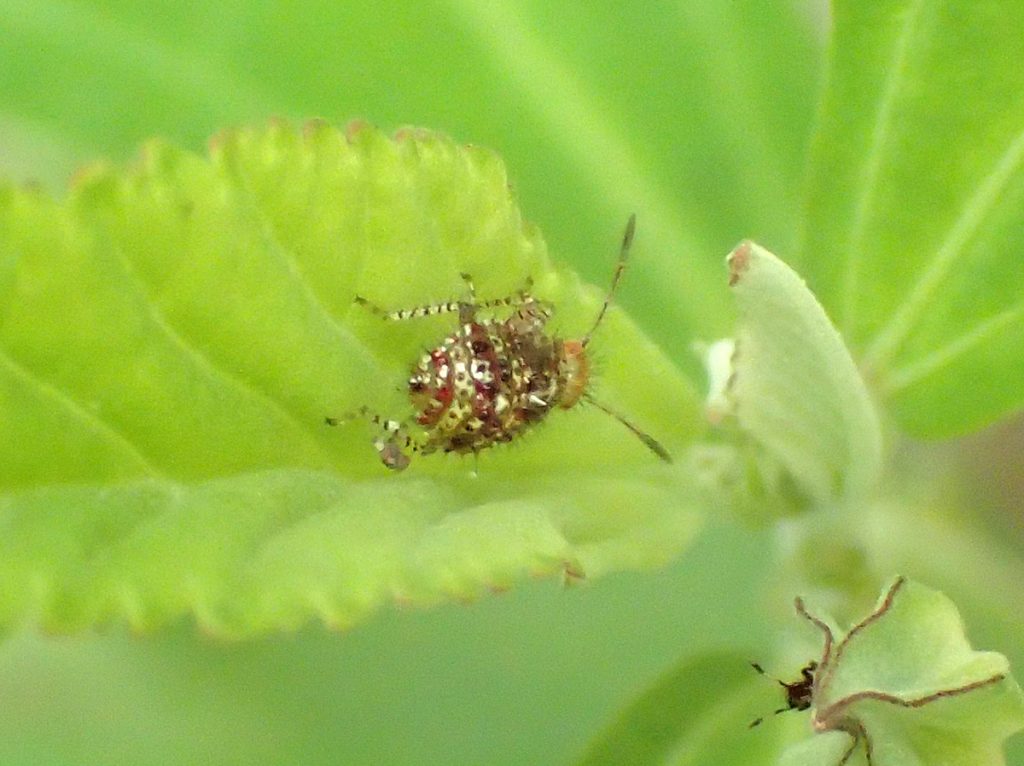
Here’s another “bad guy” in the garden:
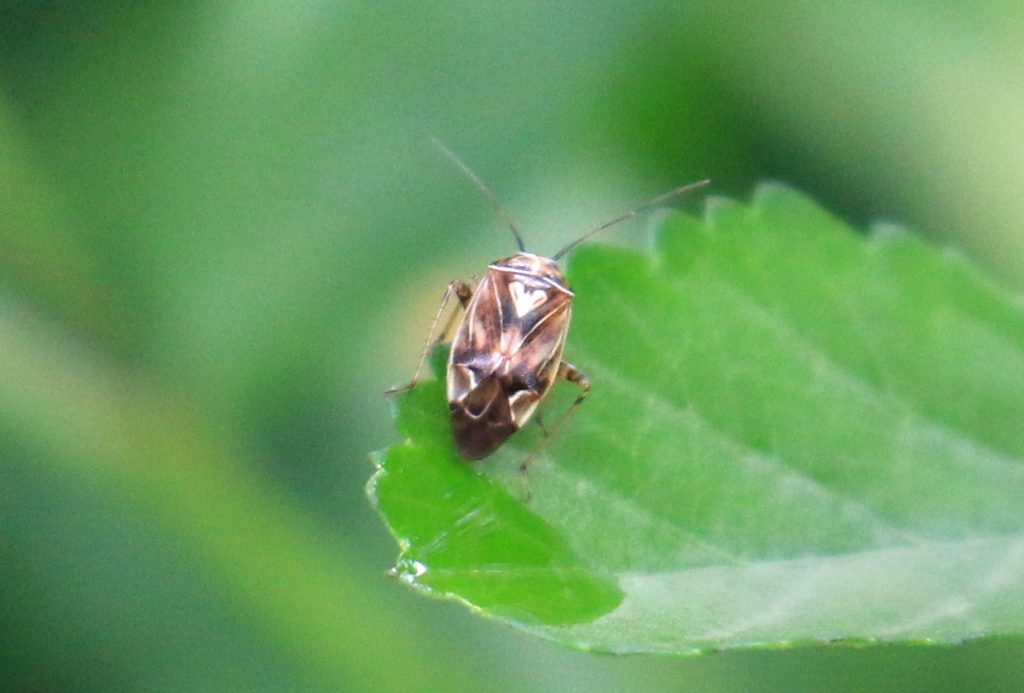
Tarnished plant bugs are considered agricultural pests. Again, we don’t have a ton here, and I haven’t seen them on food plants. In moderate numbers (I’ve only seen one or two), this is a native insect and part of our food web.
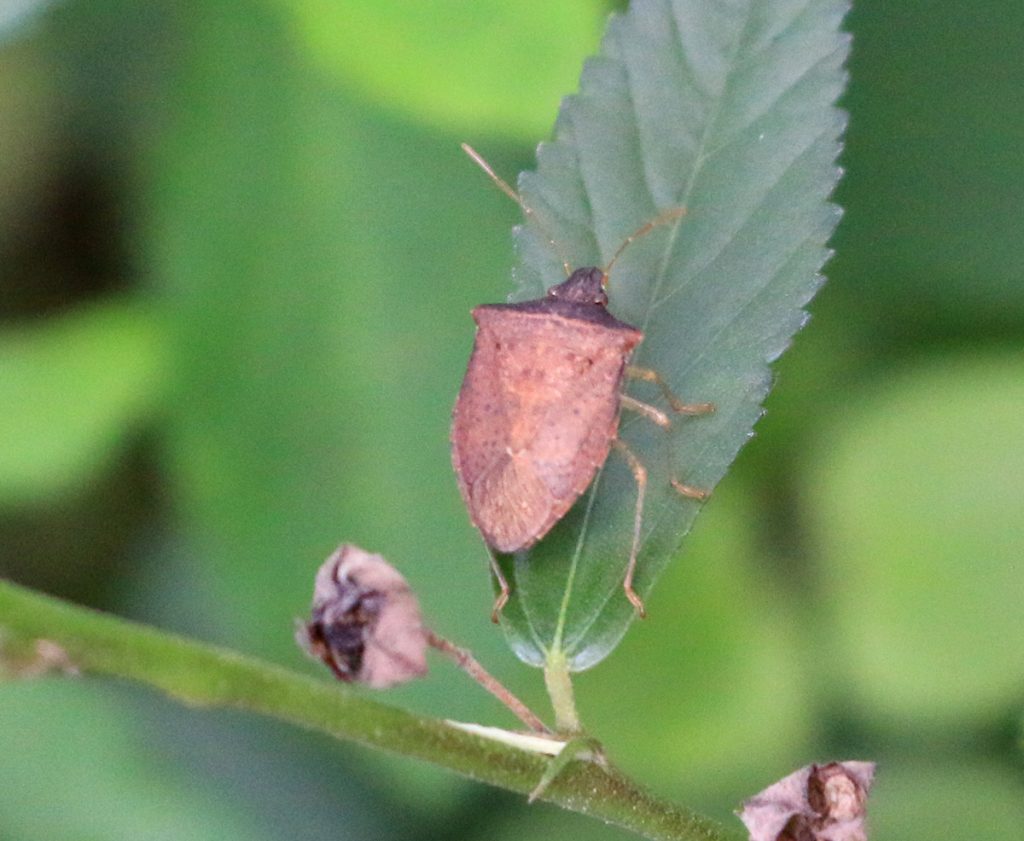
My first guess in iNaturalist was a brown stink bug, Euschistus servus, but I then changed to Euschistus obscurus. I haven’t gotten a confirmation either way. Like the other insects in this section, they suck leaves. If we had too many of any of these insects, they would harm the plants. But the holes I’m seeing on fanpetal leaves are caused by something else, something with mandibles, and we’ll get to that in a second.
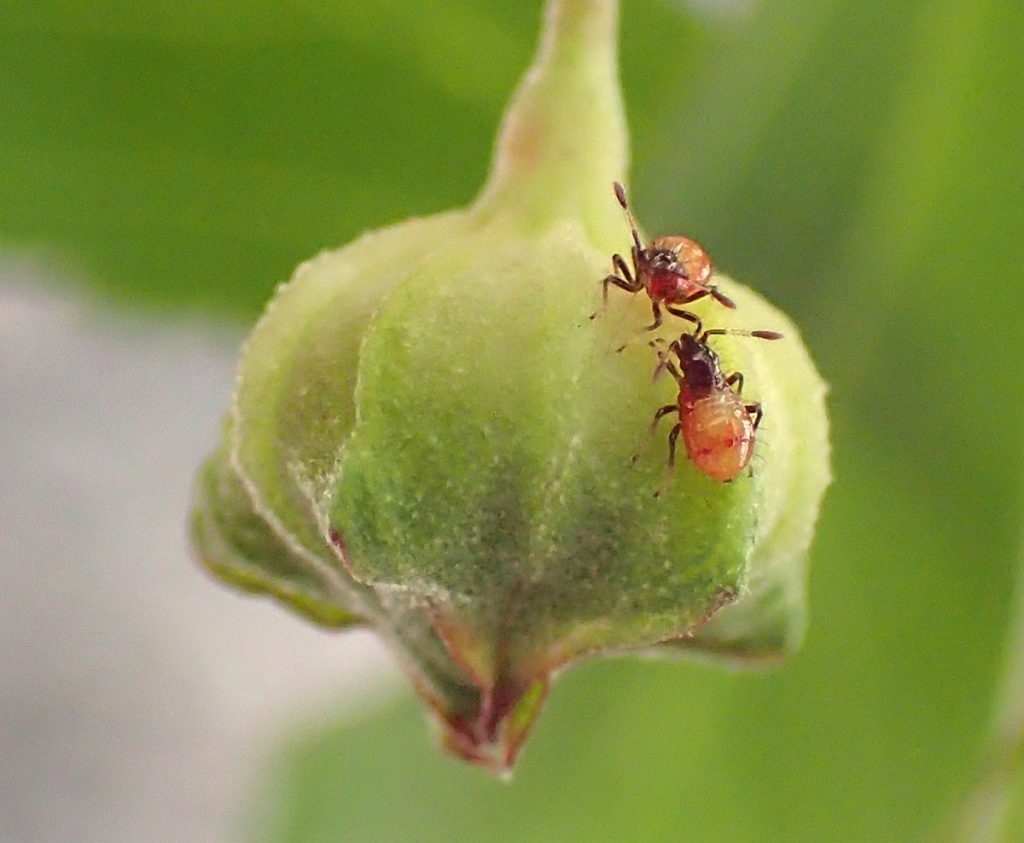
These guys aren’t likely to grow up to be anything favorable (other than bird food!). They have the look of the young of stink bugs, leaf footed bugs, or scentless bugs- plant eaters. But not all true bugs are here to eat your flowers and veggies.
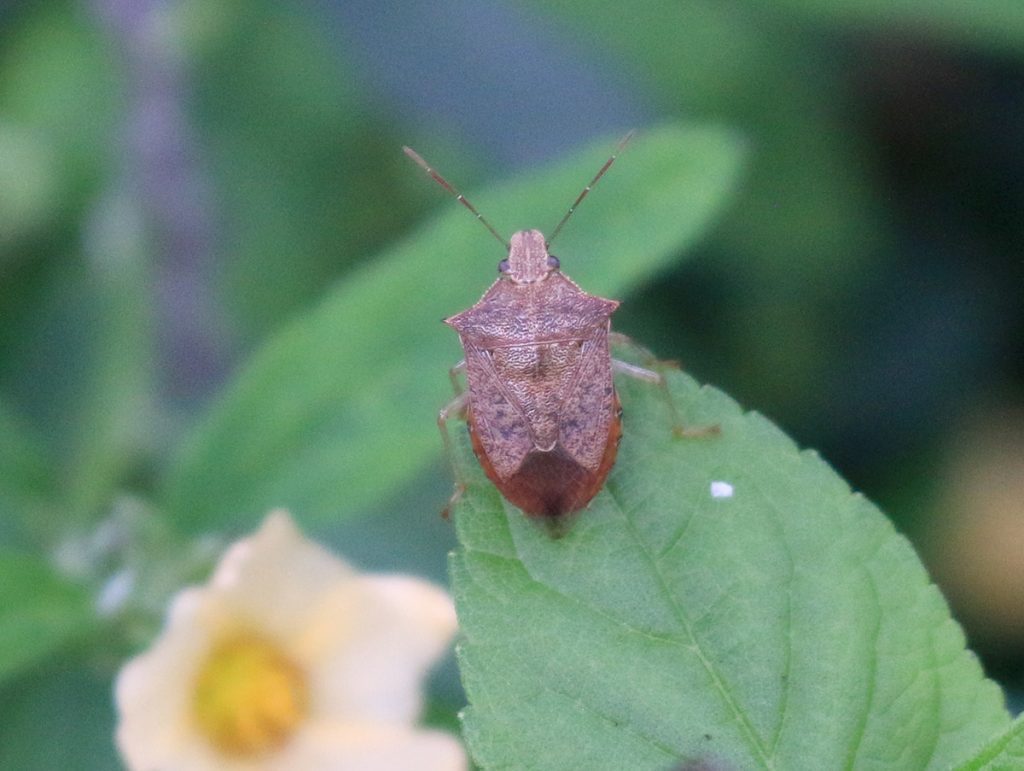
Stink bug or soldier bug?
This is where I start to lose time writing the Backyard Blog. So I’ll have to be content to say that I don’t know. I started on iNaturalist, and then moved on to the stinkbug field guide that FAMU Entomology students were passing out at a Tallahassee Science Festival a few years back. And then I spent too much time on Google image searches.
This is either a spined soldier bug or a dusky stink bug. The soldier bug is a predatory stink bug, eating caterpillars and beetle larvae. In particular, they’re known for eating potato and Mexican bean beetles, the latter of which is considered an agricultural pest. They’ve also been known to eat armyworms and plenty of other “bad guys.” During a Google image search, I even saw one eating a monarch.
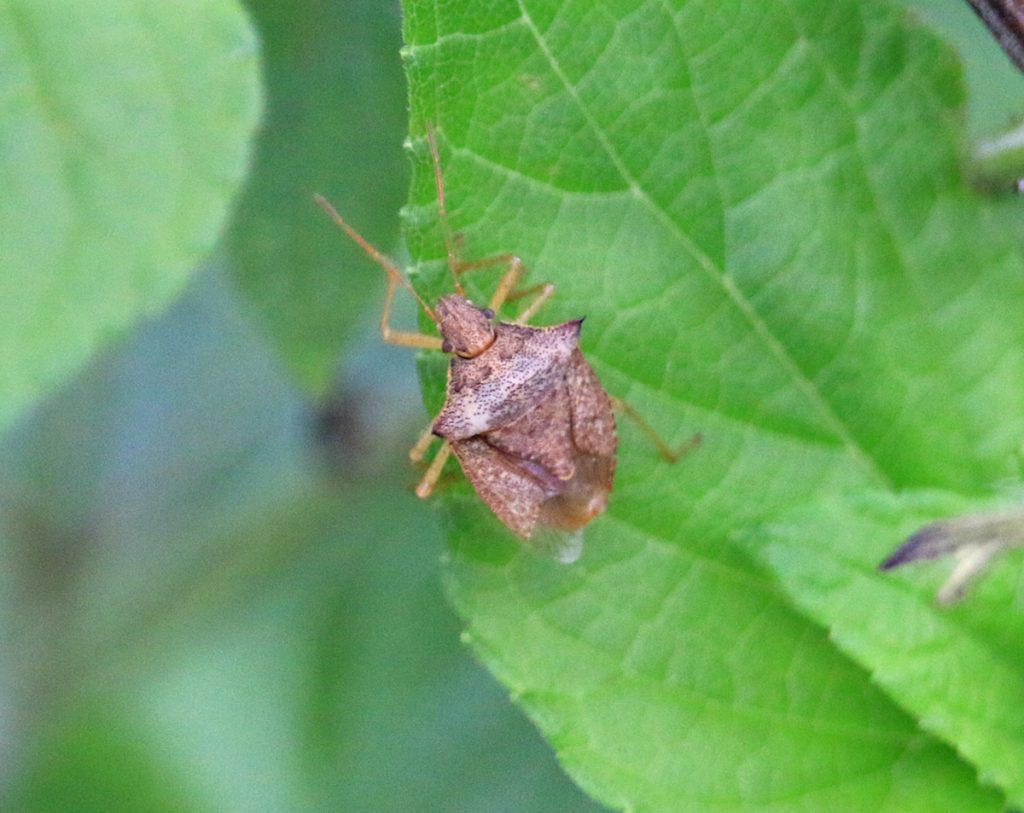
But this could also be a dusky stink bug. Had I turned the insect over and seen its underside, or gotten a closer shot of its mouth parts, I would ave had an easier time identifying. iNaturalist leans towards the soldier bug, as the dusky stink bug has not been spotted in the area (on the app). From what I read, it’s much less common than other stink bugs, though we are in its range.
Next time I see one, I’ll try and get a look at the mouth or underside.
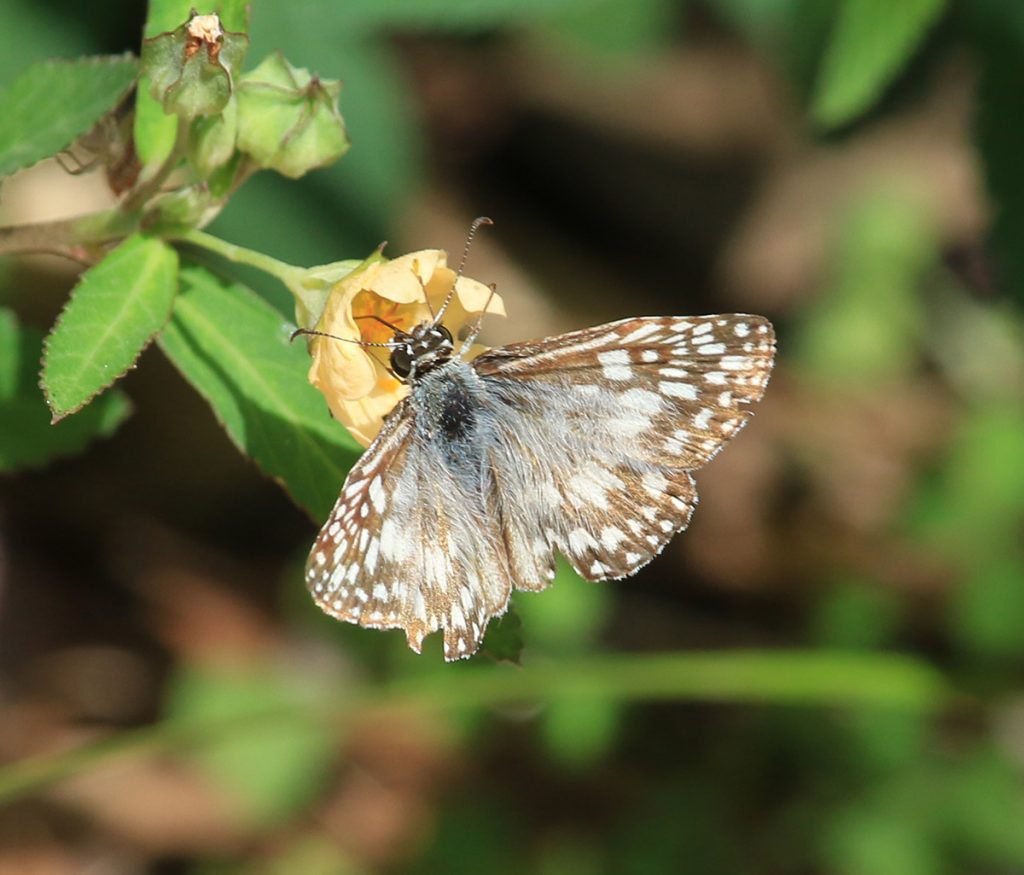
Butterflies on fanpetals
Checkered-skippers continue to be a common sight in the yard, thanks, I imagine, to the abundance of their larval food plant, the fanpetals.
This butterfly’s caterpillars are, like the stink bugs and scentless bugs, consuming the fanpetal plants. Of course, caterpillars have mandibles and cut and eat leaves, where the other insects suck the leaves. I’ve had no luck finding the caterpillars, and I was thinking that maybe they’d been sticking to the interior of the cluster of fanpetal bushes, where they’re much less accessible.
One day, I was walking behind the larger patch of the plant, when I noticed a few smaller fanpetals along the fence. I had heard that the caterpillars roll leaves in a manner similar to the long-tailed skipper, and here, finally, I saw rolled leaves.
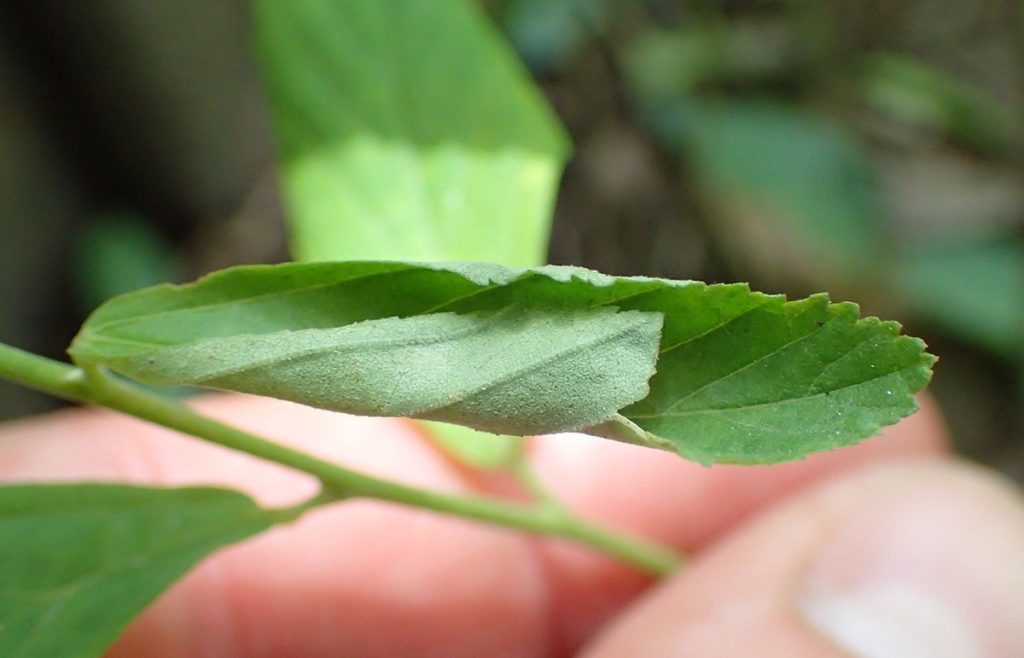
Some were rolled and had grazing damage:
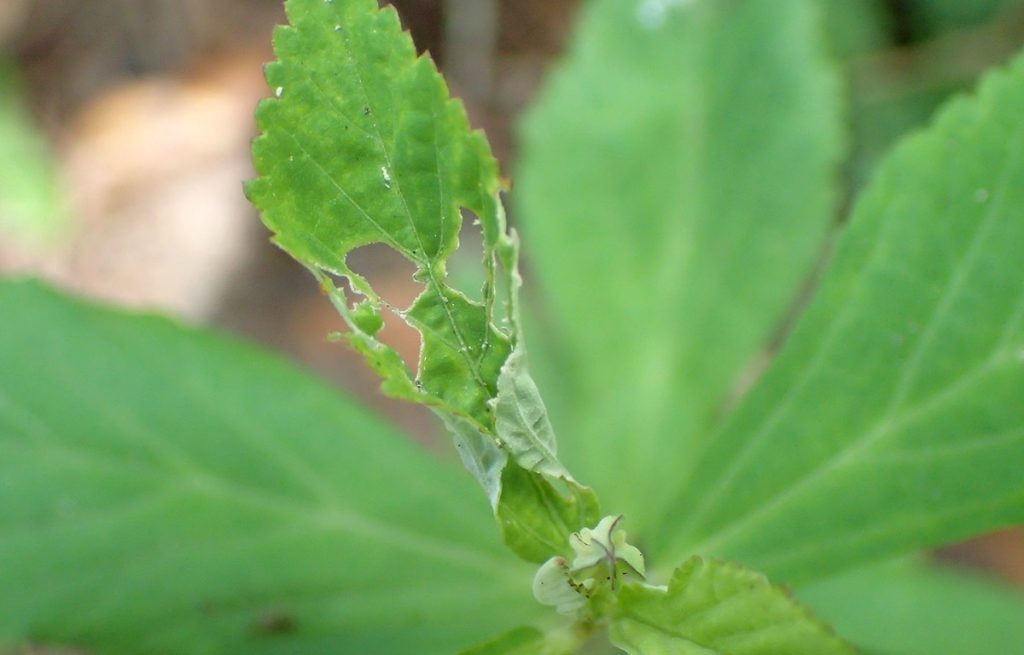
There weren’t any caterpillars in the rolls. But I have been seeing many more checkered-skippers flying in the yard, so maybe a batch of caterpillars had recently transformed and hatched. I’ve been seeing tropical checkered skippers; those are the ones I’ve seen laying eggs on the fanpetals. Towards the end of June, I saw a white checkered-skipper in the yard as well.
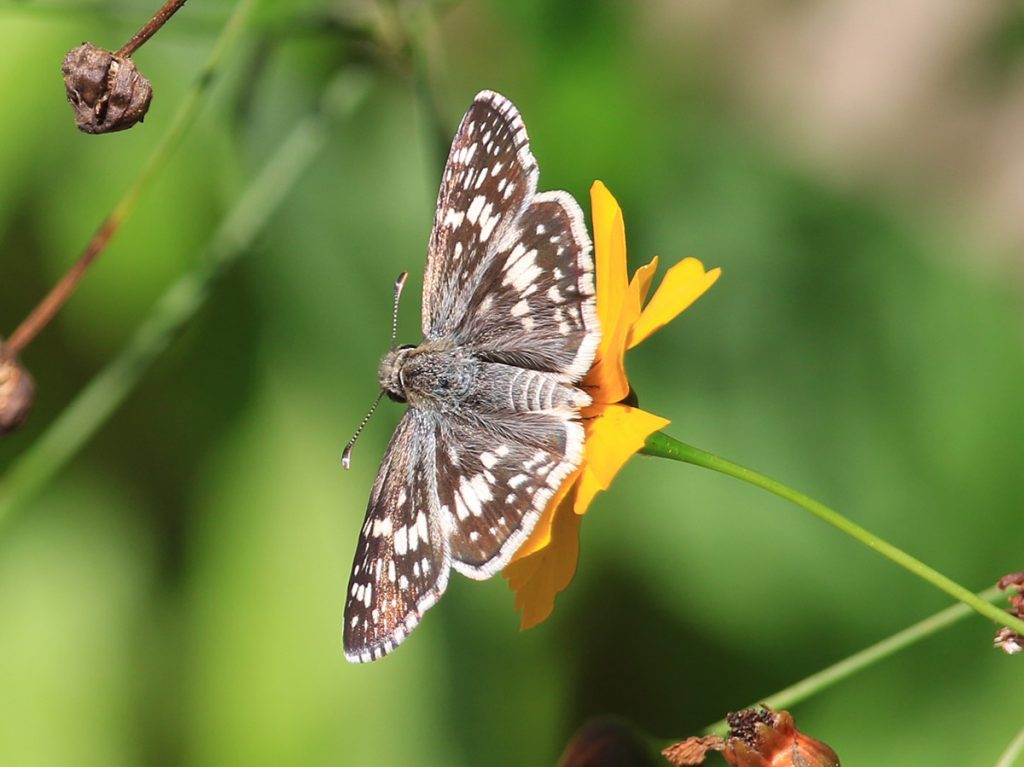
Fanpetal flowers are also popular with the smaller bees, and the smaller butterflies in the yard:
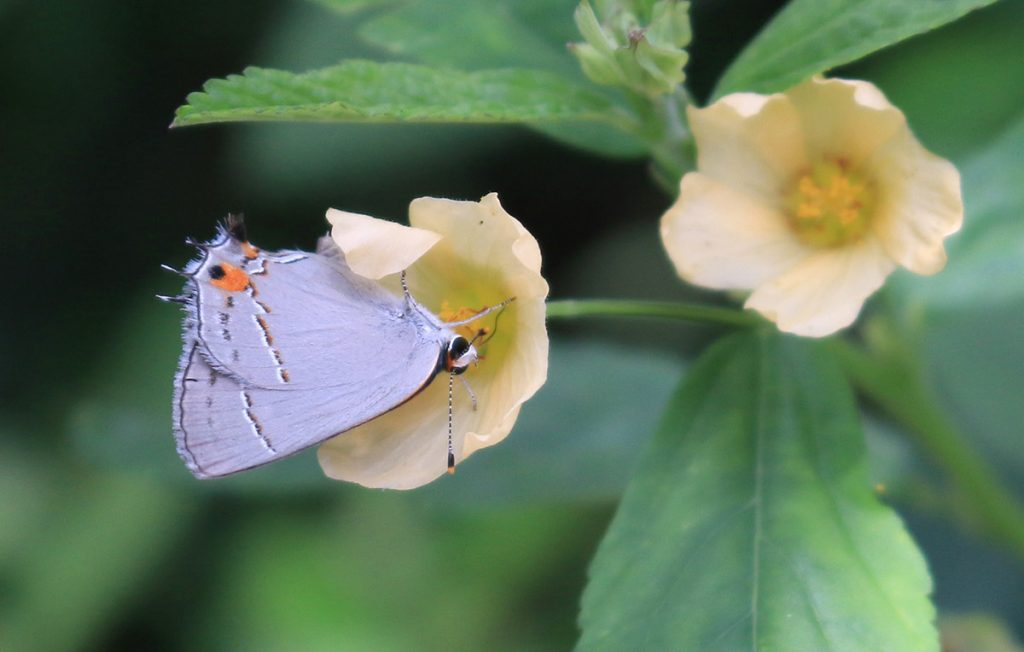
A Busy Month for Wasps in the Yard
We had a good variety of wasps in the flower patch and on our potted flower plants. Here’s one I hadn’t seen in the yard before:
Feather-legged scoliid wasp (Dielis plumipes)
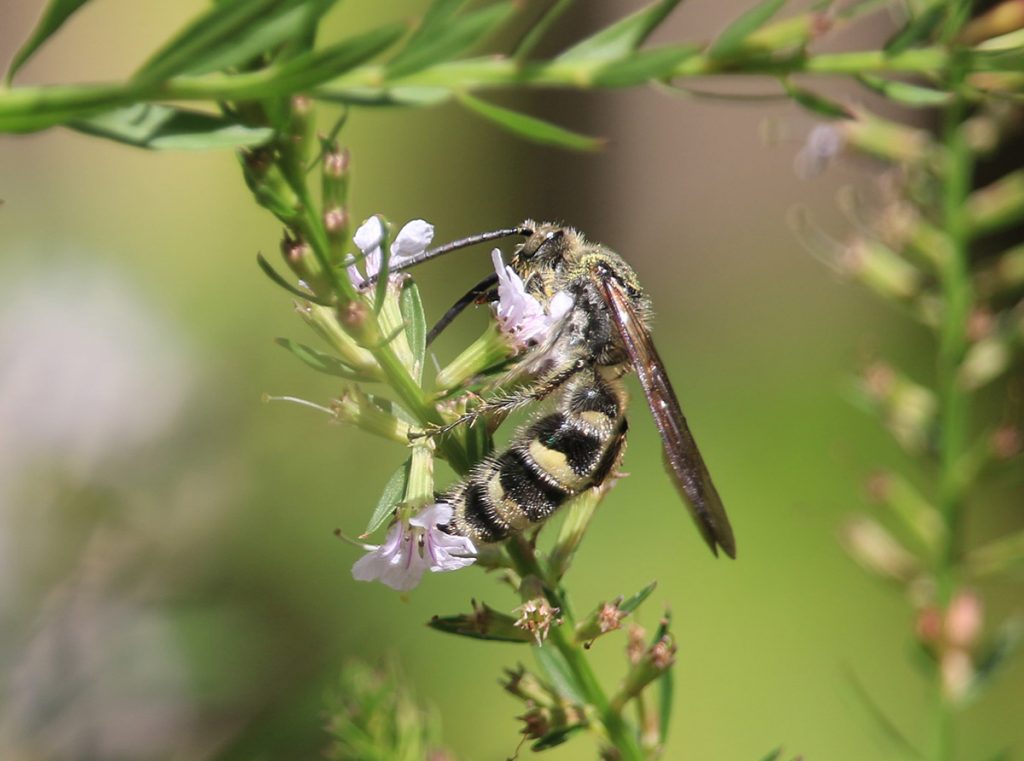
This is one of the cooler looking wasps I’ve seen in the yard. Reading an IFAS page on them, I learned that their larvae parasitize scarab beetle larvae.
EDIT, February 19, 2021– Parancistrocerus fulvipes, a member of potter and mason wasps
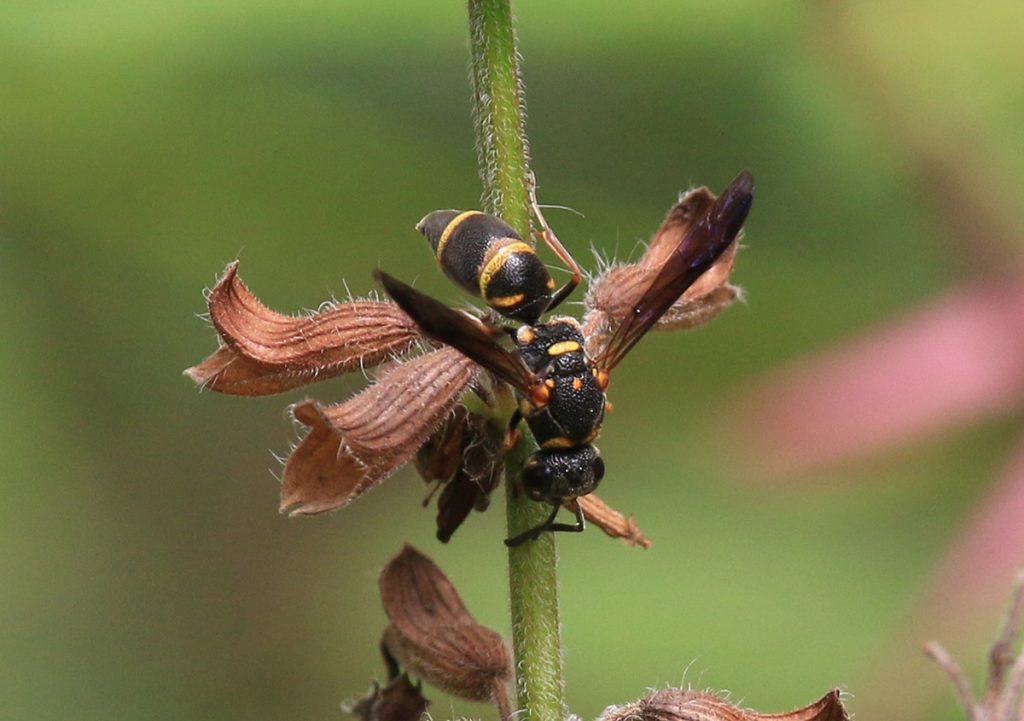
February 19, 2021– The top two iNaturalist identifiers of potter and mason wasps agree, this is a Parancistrocerus fulvipes. These are the same two that identified the Euodynerus foraminatus-complex wasp I saw in March. Both wasps have a similar characteristics, and differences I don’t see. I looked at all of my potter and mason wasp observations on iNaturalist, and of all the species I’ve seen, yellow bands are common. These two were the most similar in appearance, though.
Learning about insects in the yard is an ongoing process. Being wrong, often, is part of that process.
Original Entry– Here’s another appearance of a mysterious wasp I first saw in March (Euodynerus foraminatus-complex). According to an entomologist who commented on my iNaturalist entry, this resembles several related species, but none exactly. It might even be an un-described species. So I’m happy to make another observation and ID it as a member of this complex. This is the citizen science side of iNaturalist, where we can gather visual information for people who are trying to detangle, in this case, the different related species within this complex.
Fraternal potter wasp (Eumenes fraternus)
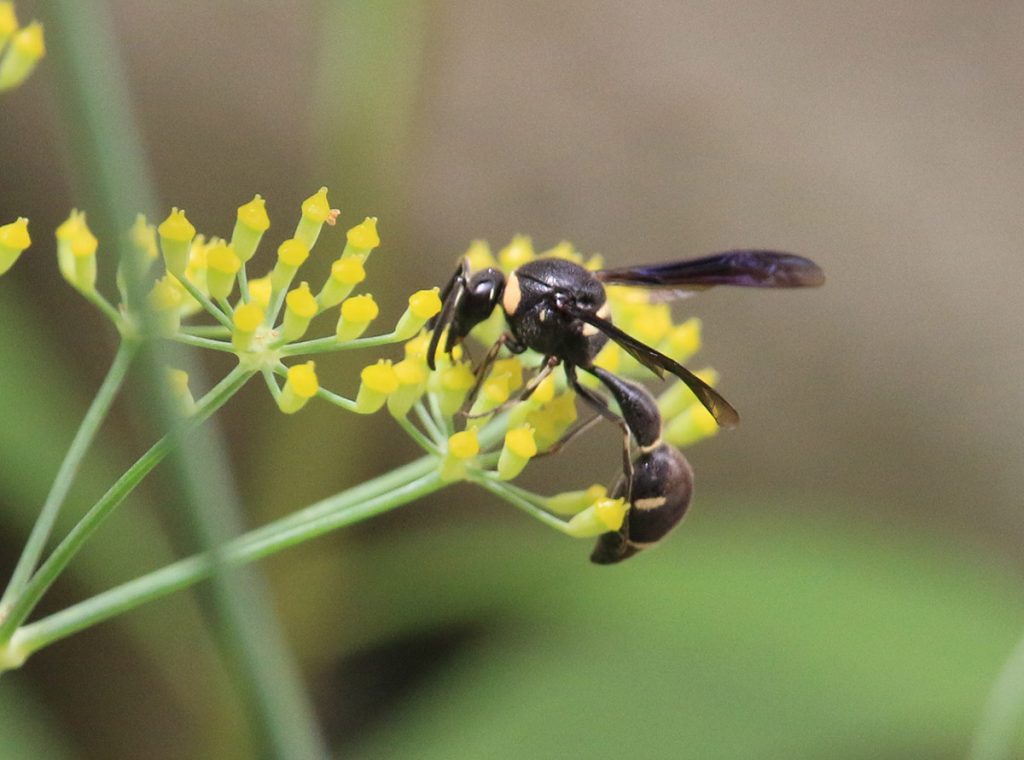
Our fennel has been flowering, and we’ve seen a few different wasps on them, as well as the tiny Dialictus bees. I last observed this wasp last July.
Blue mud-dauber wasp in the genus Chalybion
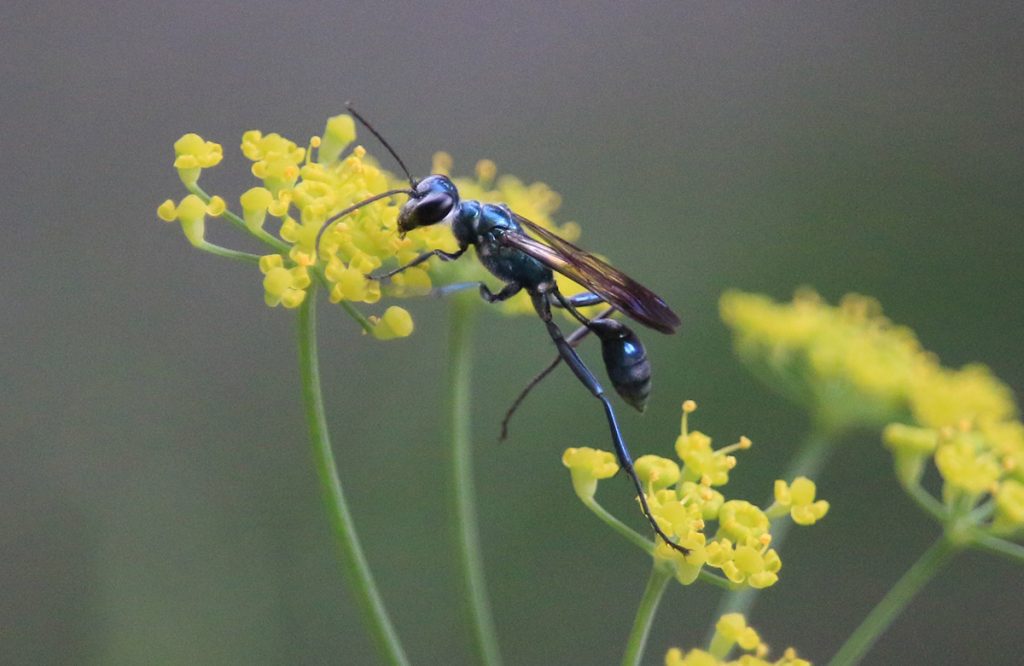
I’m not sure of the species on this one. I ID’d it as a common blue mud-dauber. Another user suggested Zimmerman’s mud-dauber, which is a rarer wasp. It’s a much less common wasp, and hasn’t been iNaturalized within our immediate vicinity. I clicked compare and looked at photos of both species versus the photos I took. I can’t really see a difference between the two, so I can’t make a confident identification.
Wasps, monarchs, and the milkweed ecosystem
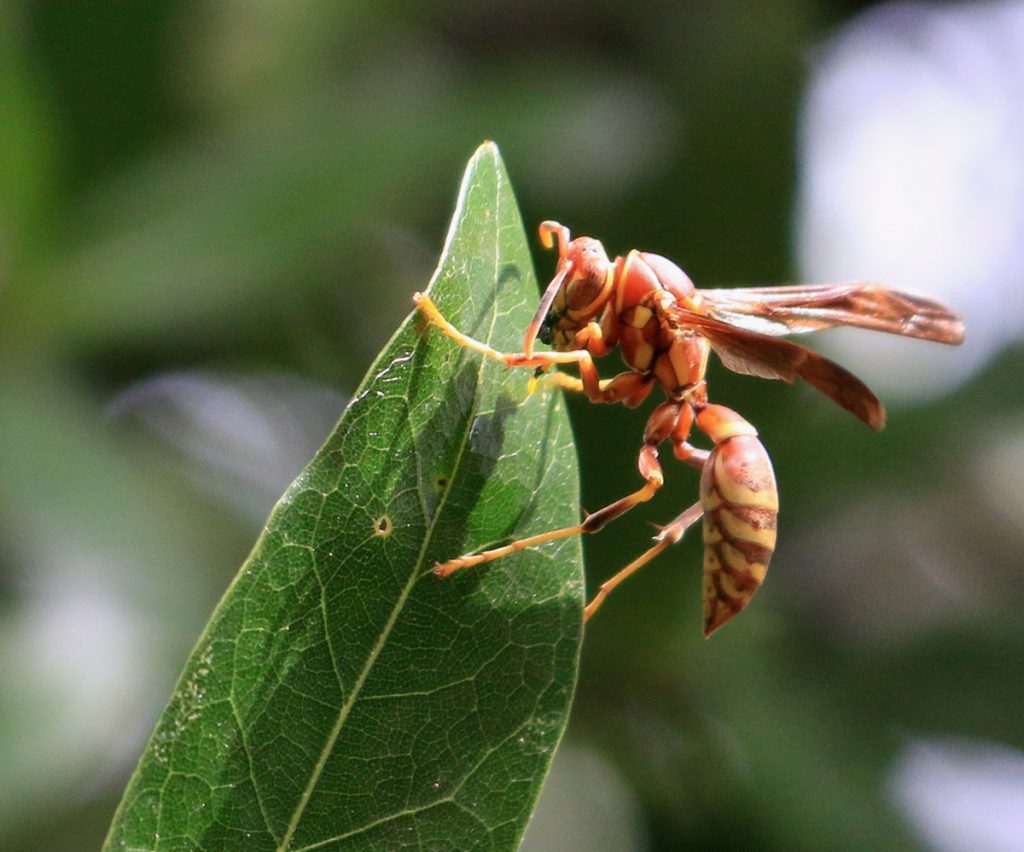
I chased this Guinea paper wasp of a milkweed plant, and it came to rest a little higher up on an oak tree. The milkweed plant had this younger monarch nestled in its flowers, and another nearby under a leaf.
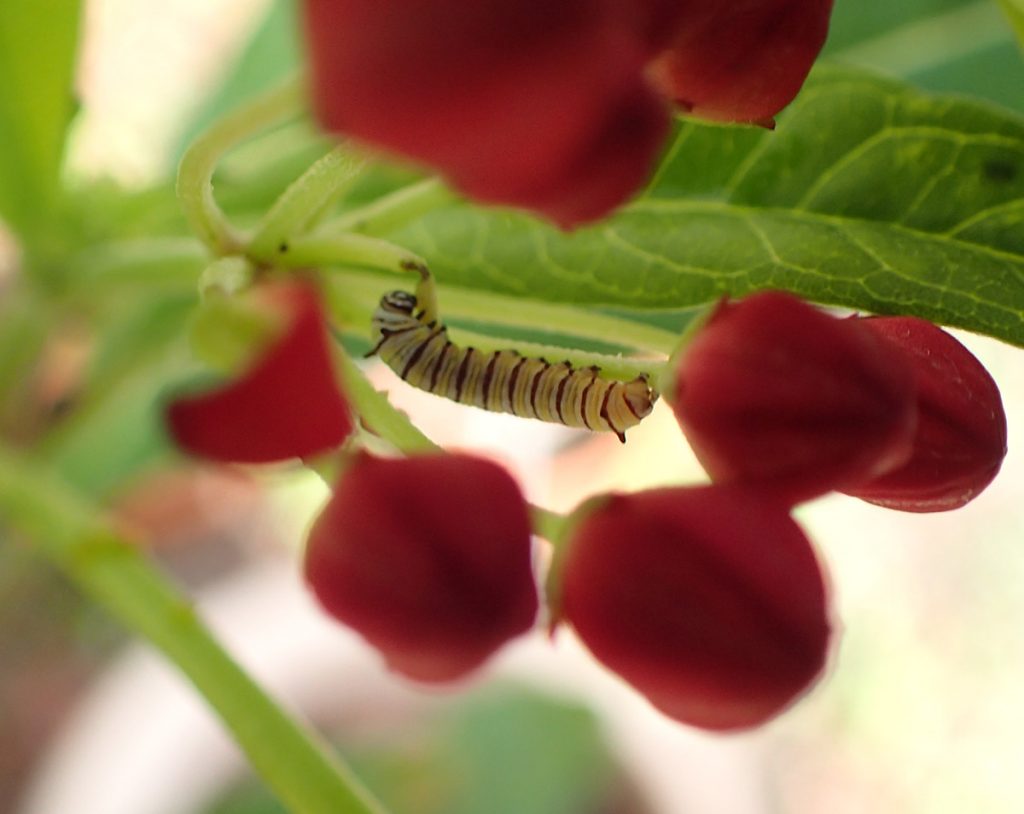
First instar caterpillars often hide within the cover of flowers or new leaf growth. These flowers weren’t yet open, so a pollinating wasp maybe wouldn’t visit this plant. But the way this paper wasp was visiting the flowers didn’t look like pollinating to me:
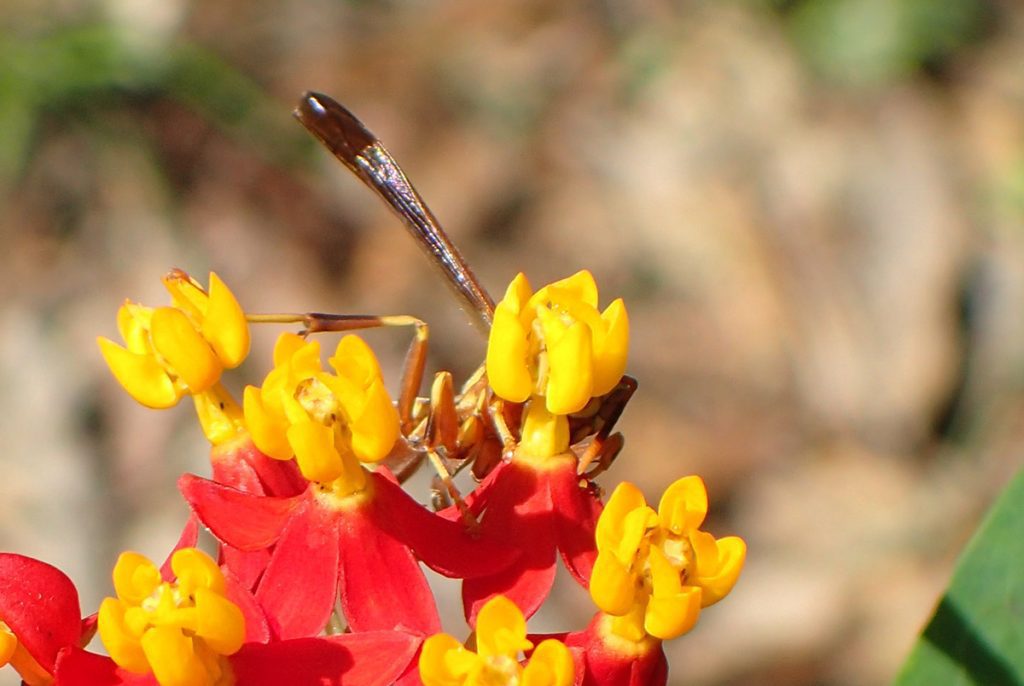
Paper wasps have carried off first instar monarchs before in our yard. But I couldn’t stay out there all day chasing this wasp away. I considered just swatting it down. Typically, I like to let things play out as they will in the backyard. Monarchs have always had to fend for themselves in the wild, and surviving predators is a part of any animal’s evolution. The fittest survive. I only saw two caterpillars this day on our seven or eight plants. Typically, monarchs will lay a larger number, like many animals do. If two out of twenty or thirty eggs survive, they’ve replaced their parents and kept the population stable.
Anyhow, these caterpillars disappeared. I hadn’t seen many monarchs this season yet. Later in the month, though, I looked out my window and saw this:
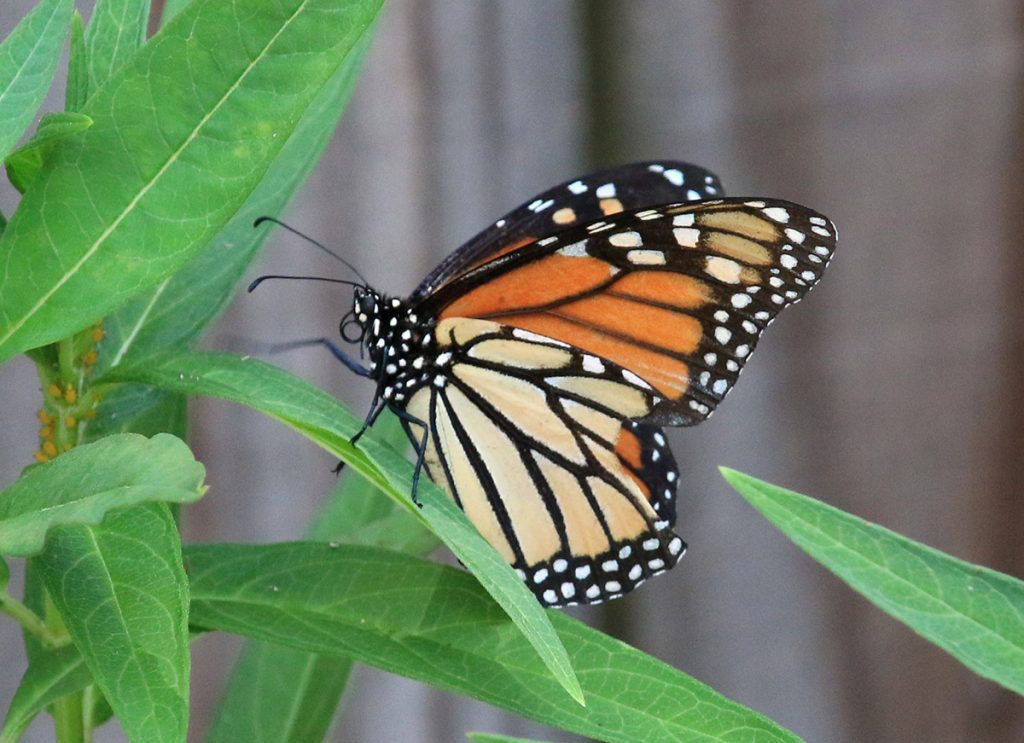
As I was writing this, on July 2nd, I decided to go out and see if this one’s caterpillars are still on the plants. I spotted two fairly easily, third instar. By now, they’ve eaten enough toxic milkweed leaves to be unpalatable to most predators. Their odds of survival are much higher.
Pests and beneficial insects on our milkweed
One more milkweed consumer I saw on our plants towards the end of June:
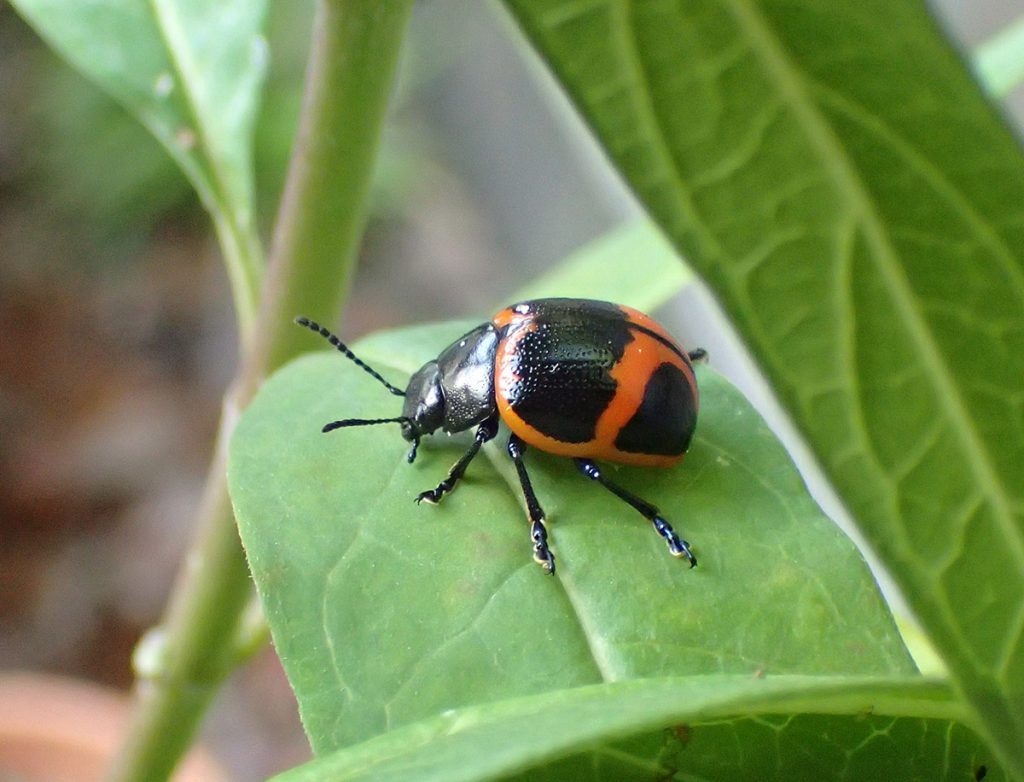
I only saw the one, on this one day. So I’m not worried about this insect many consider a pest.
Speaking of pests, you may notice orange milkweed aphids on the plants. I’ve seen some syrphid larvae (which eat aphids) on the plants. Also, on the day I found myself chasing wasps, I saw this:
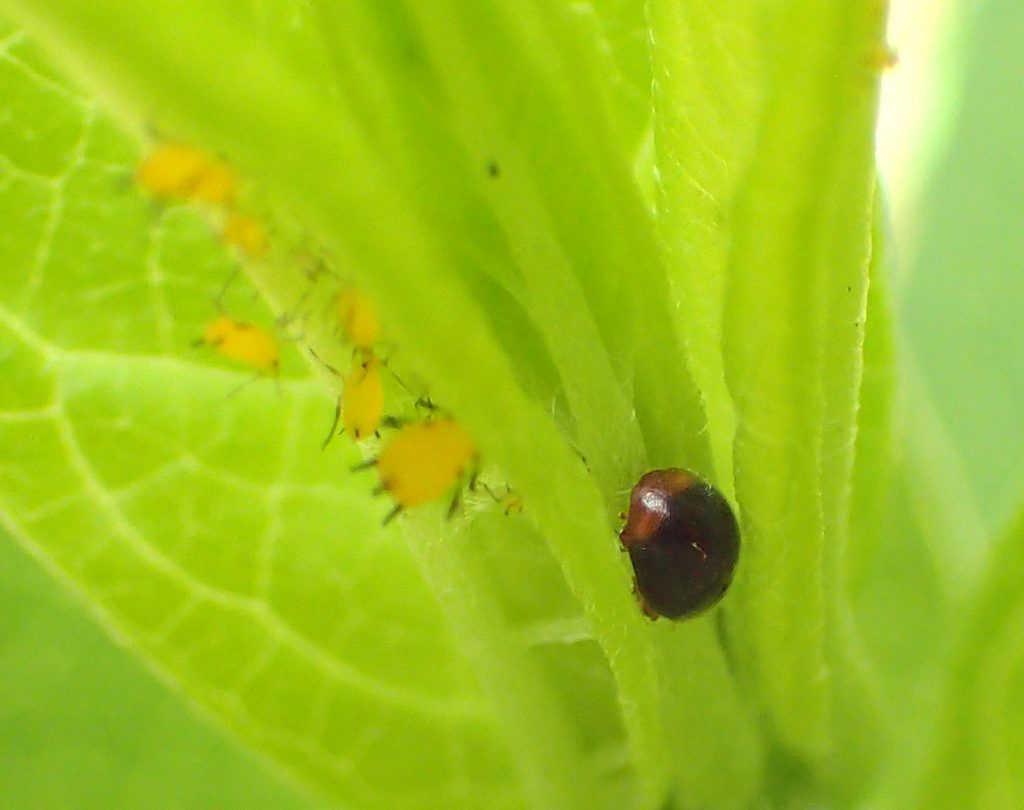
One the one hand, here’s a beneficial insect that eats aphids. On the other, I’d previously learned that ladybugs can eat monarchs caterpillars. I get busy sometimes, but maybe I need to stay on top of these aphids (even if I like feeding baby hoverflies).
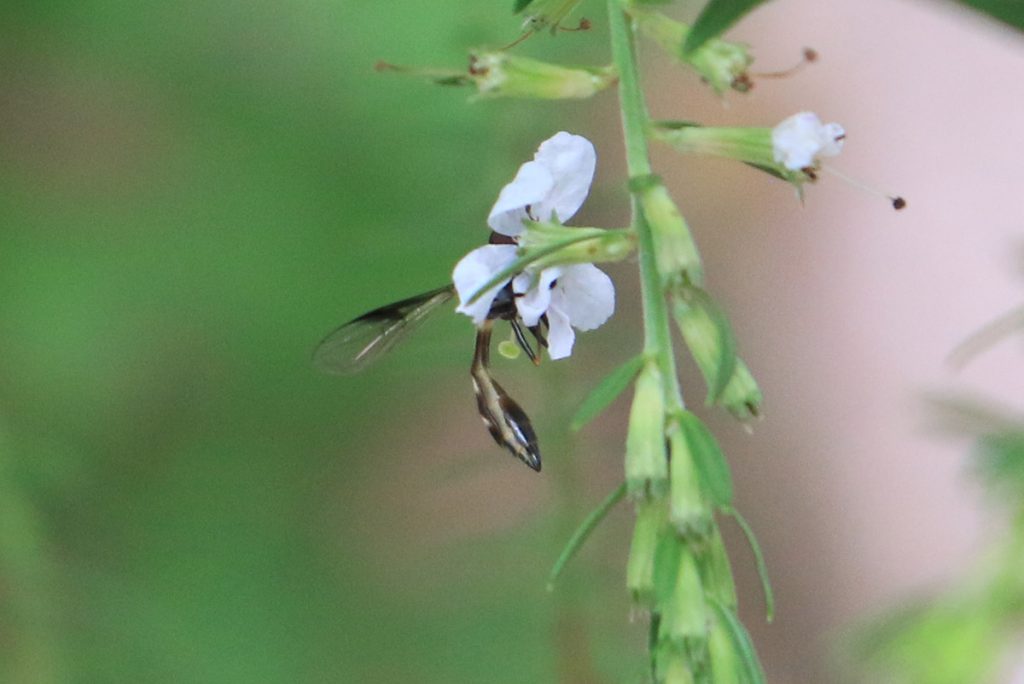
A Quick Check-In with our Giant Swallowtail Caterpillar
This year, we’ve only had one giant swallowtail caterpillar, though for the first time I saw an adult nectaring on our flowers. I’ve covered this caterpillar species before, but it is one of my favorites. So, quickly, here are a few photos of my one of the funkiest looking animals to grace my yard:
It got nice and big, and then disappeared. They do make chrysalides on the plant, but they can also wander off and find a nice spot on the fence. I’ve looked over that fence and not seen it. The chrysalis will be the same color as the fence, and I’ve missed them before. I’d like to think this one is safe somewhere I (and its potential predators) can’t see it.
Other Plant Consumers in the Yard
I only noticed one moth caterpillar in our yard this June:
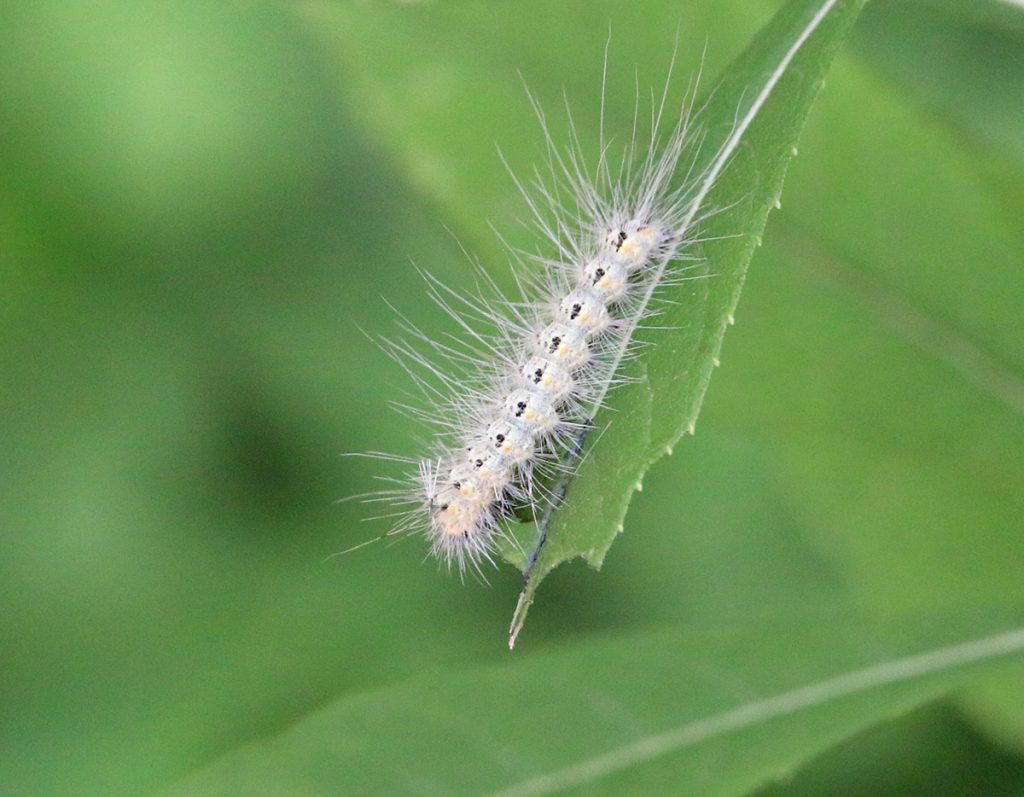
Webworms are the caterpillars that make little webbed enclosures up in trees. In their later instars, they break out and find other plants to eat. Here’s a look at its face as it eats an ironweed leaf:
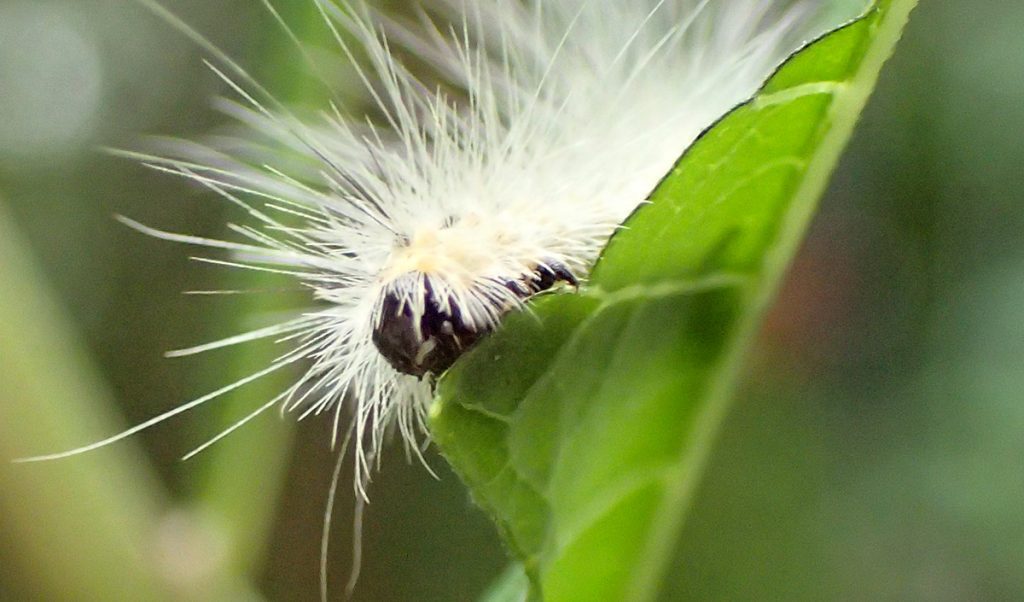
Meanwhile, back in the flower patch, I saw a couple of larger plant cosumers:
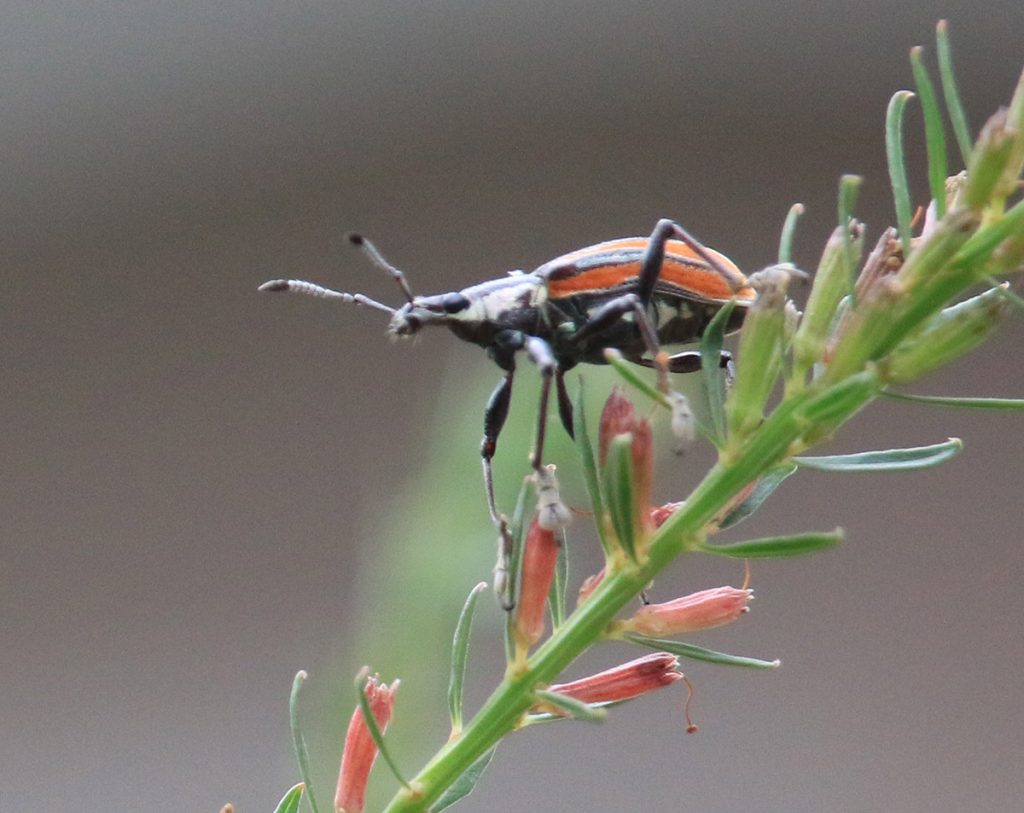
Here’s a case where I might want to start iNaturalizing insects soon after I photograph them. This is a nonnative insect that’s considered an agricultural pest, especially on citrus plants. This loosestrife is on the other side of the fence from our lemon tree. I’ve only ever seen this insect briefly on this one occasion. But I’ll keep an eye out for it.
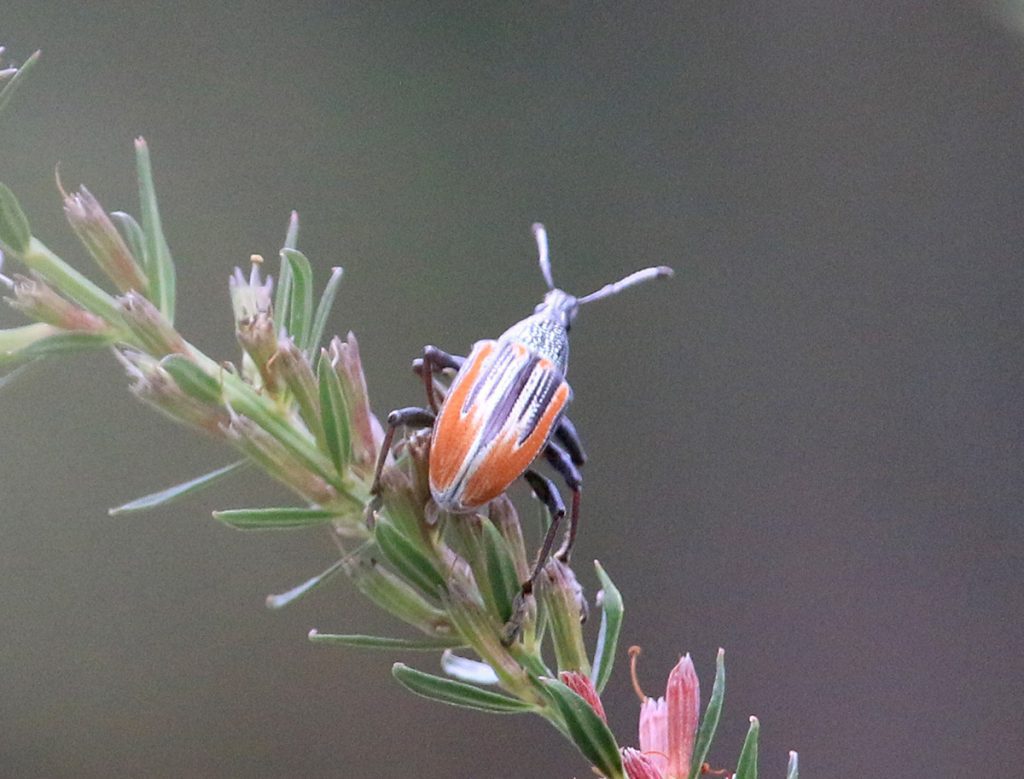
It does look cool, though. These weevils vary a lot in the way they look.
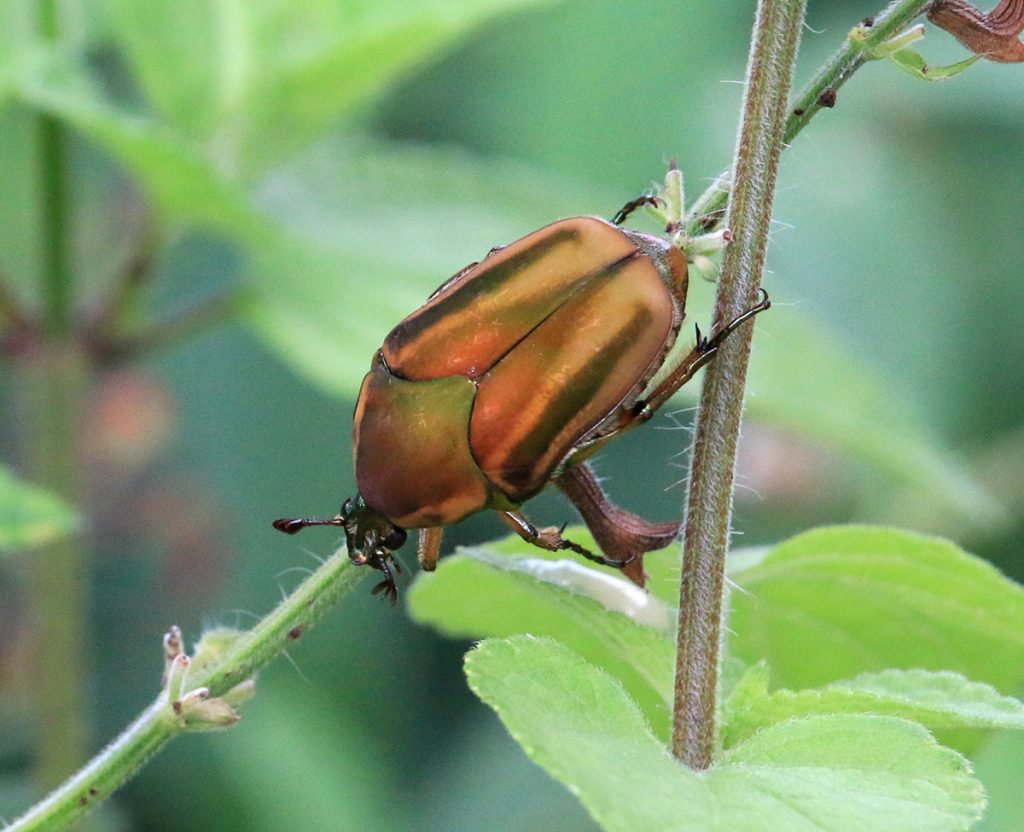
Here is a pretty, nice sized beetle. From what I read, this species is not considered a pest because so many animals eat its larvae. So it never gets out of control.
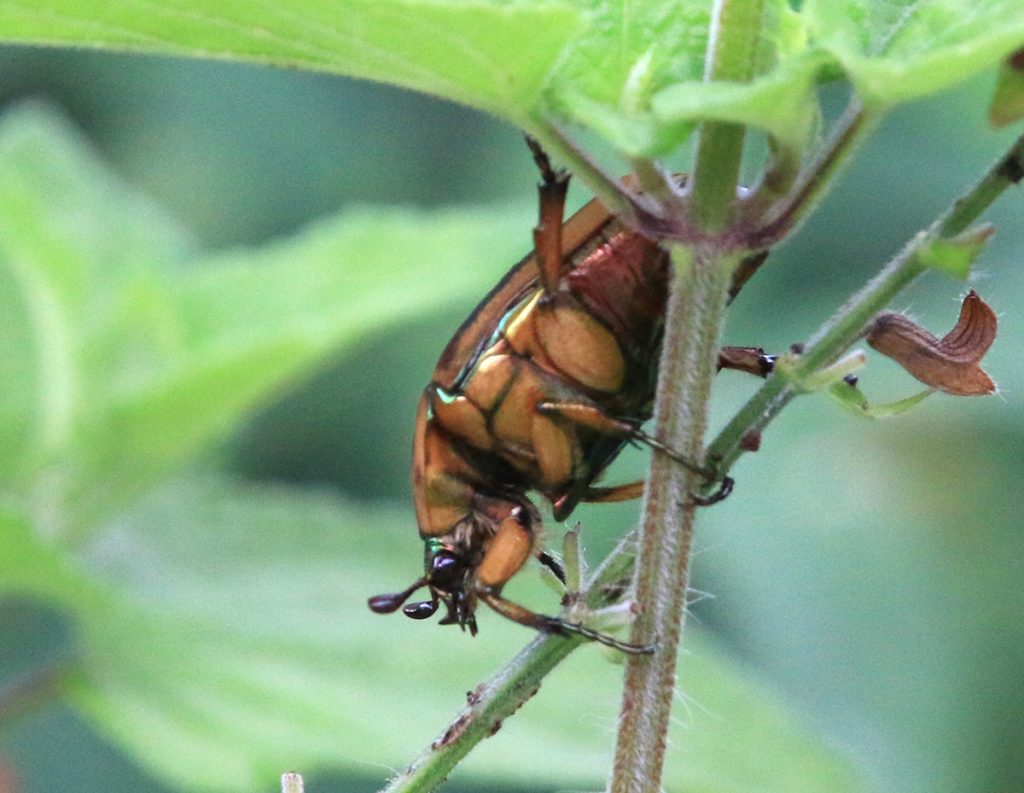
Spiders
It should come as no surprise that, as insects increase in number, so do spiders.
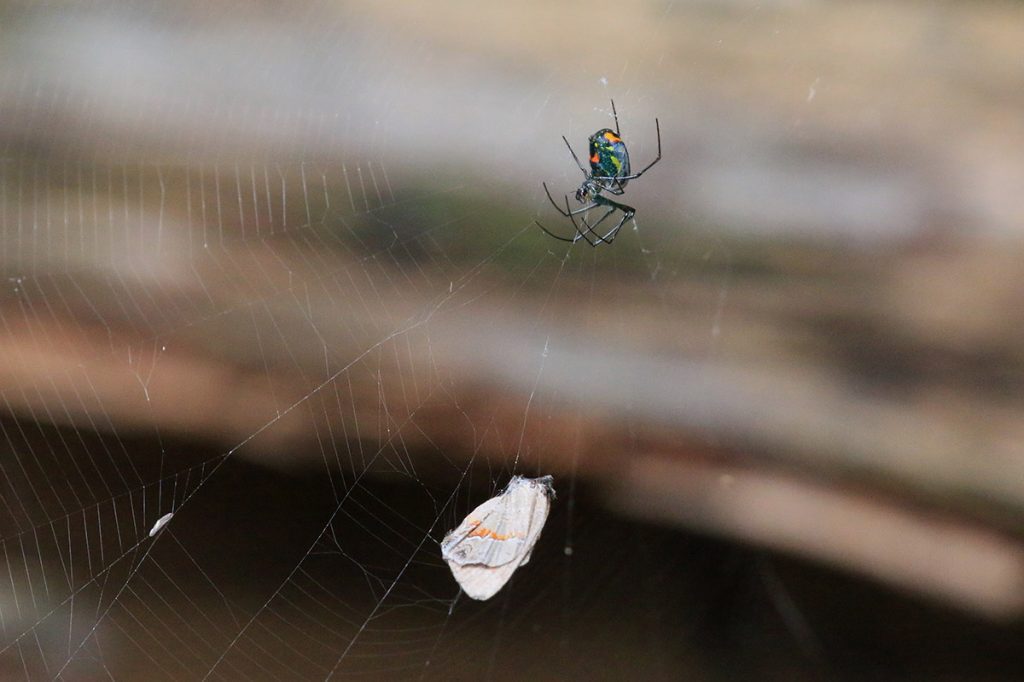
I think this is an orchard orb weaver, and it seems to have captured on of those cute hairstreaks we’ve been seeing in the yard.
I watched these one evening, thinking perhaps they might be courting. Or maybe it was a territorial battle. Either way, one of the spiders took off.
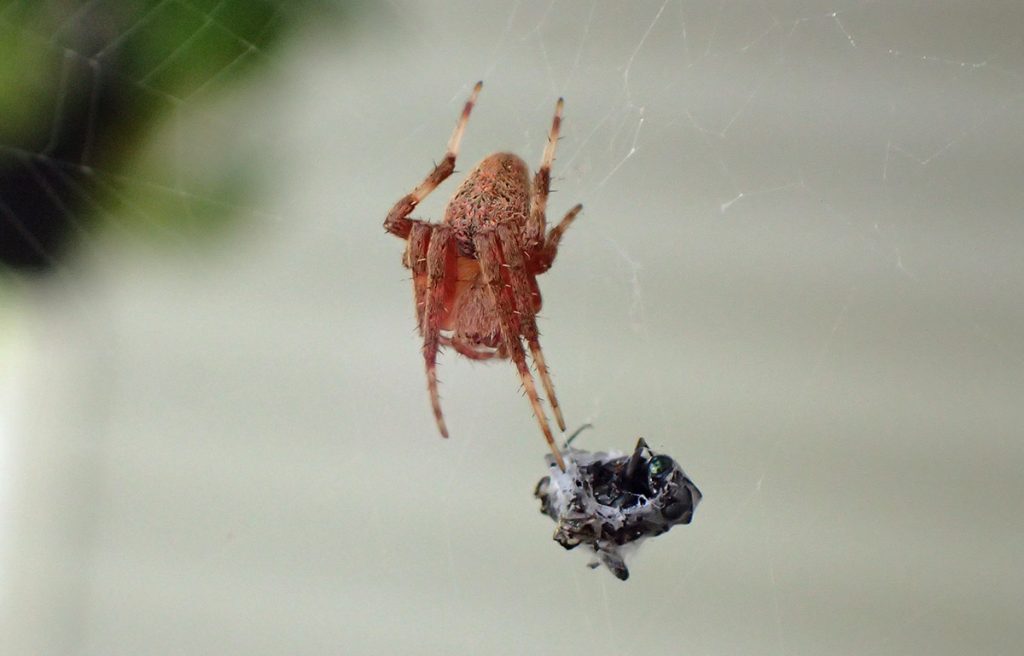
I think that might be some sort of housefly in its net?
I found a couple of these pruning tomato leaves:
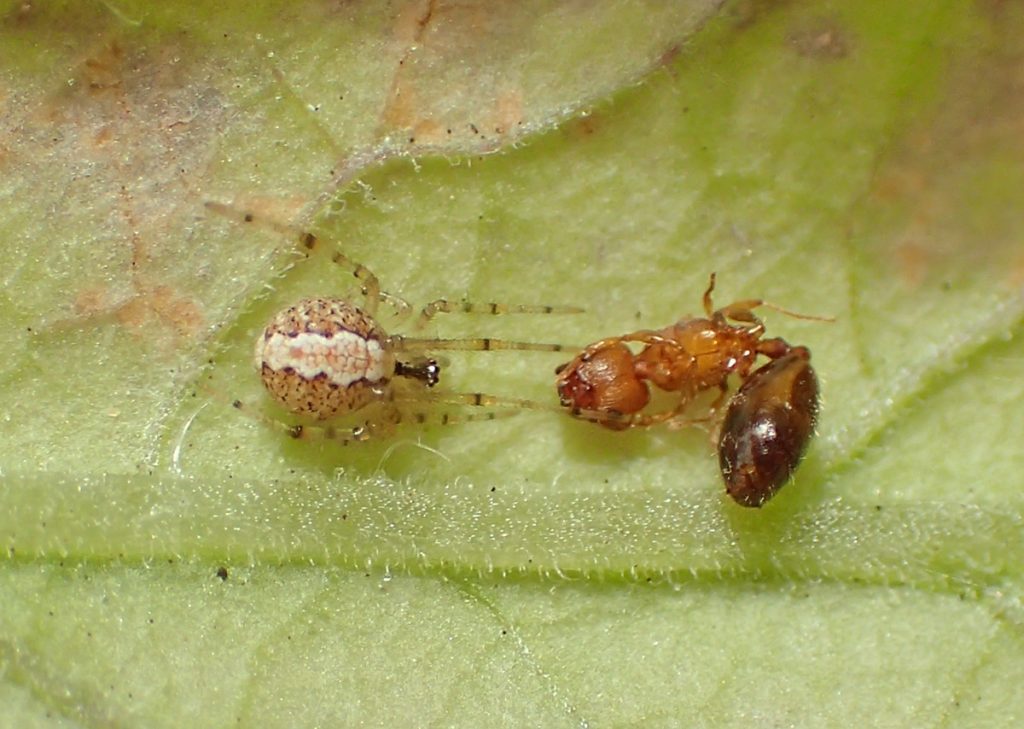
Here’s one from under another leaf. Look how long two of its legs are:
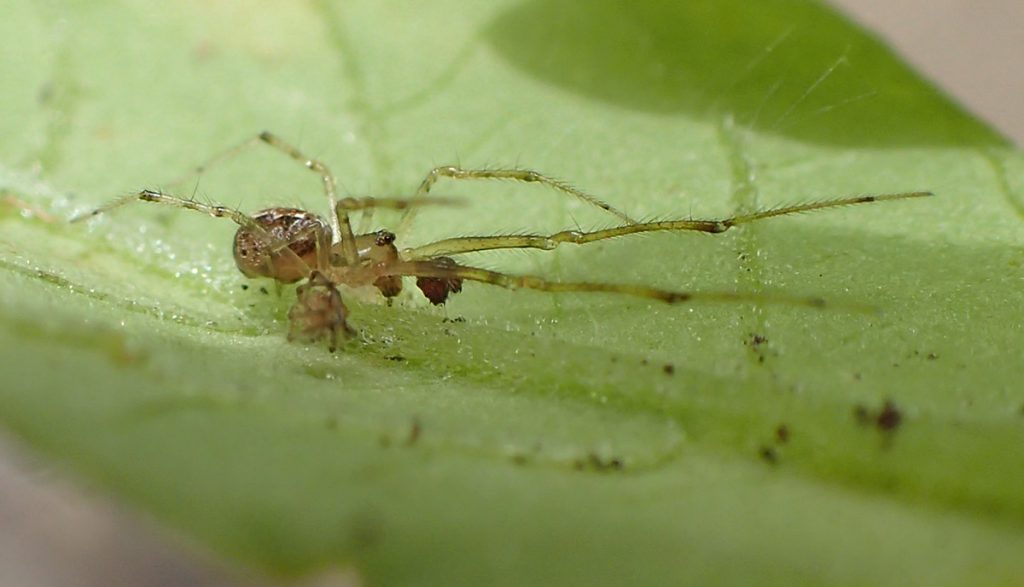
A couple of weeds in the yard
Cutleaf groundcherry
Last year, I shared an image of a groundcherry plant without showing the fully grown fruit. The Physalis genus includes tomatillos, and we have a few species native to Florida as well. When the family and I hiked the Garden of Eden Trail, I photographed one of these species. It’s cool to have a related species growing in my yard as a weed. In fact, we saw a few plants that day that grow as weeds in our yards. This is why I like to write about “weeds.” If we know what is and isn’t native, we can manage our yards and promote plant biodiversity that pays off in the animals we see.
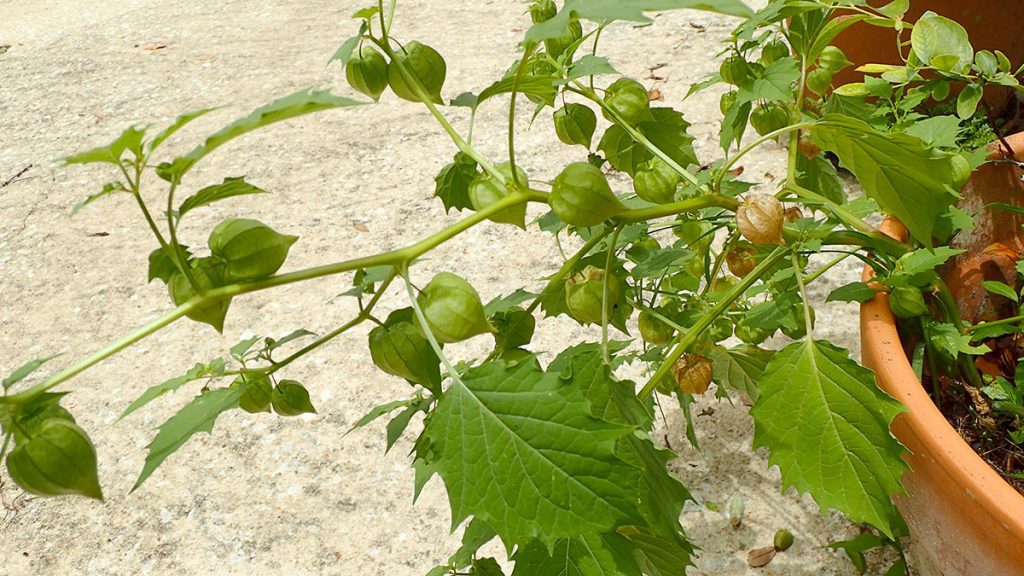
The two species iNaturalist shows in our area (besides a coastal variety) are cutleaf and clammy groundcherries. I saw a clammy on our hiking trip, and this is the cutleaf. Here are its fruits, closer up:

Green groundcherry 
Mature groundcherry
When their husks get brown, the fruit inside is ripe. They then fall to the ground:
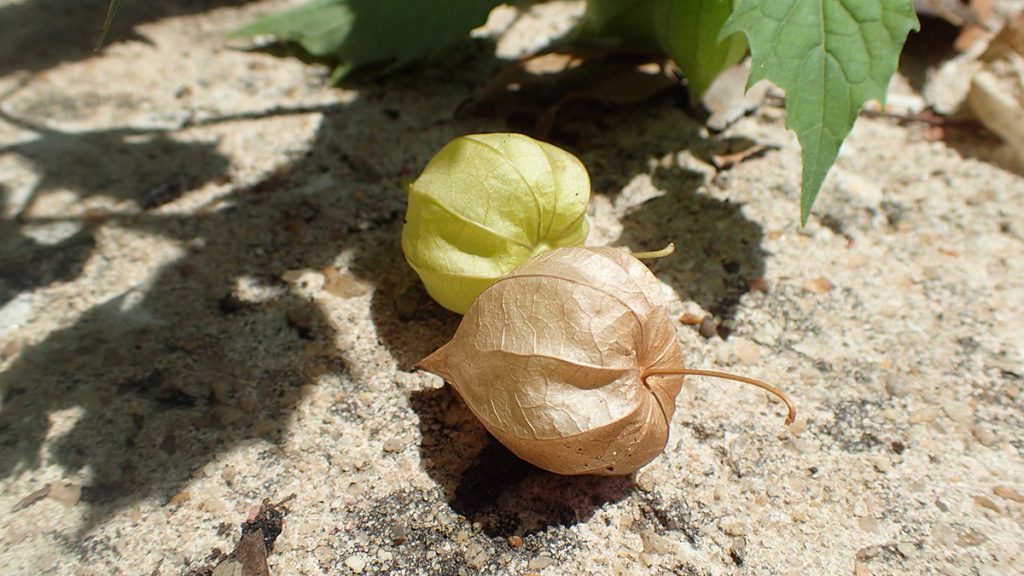
The fruit is on the inside. I need to read up a little more, and refresh what I read last year. I read that this is edible, but that it’s only really ripe when it’s red. Whenever I uncover the fruit, though, it’s always green:
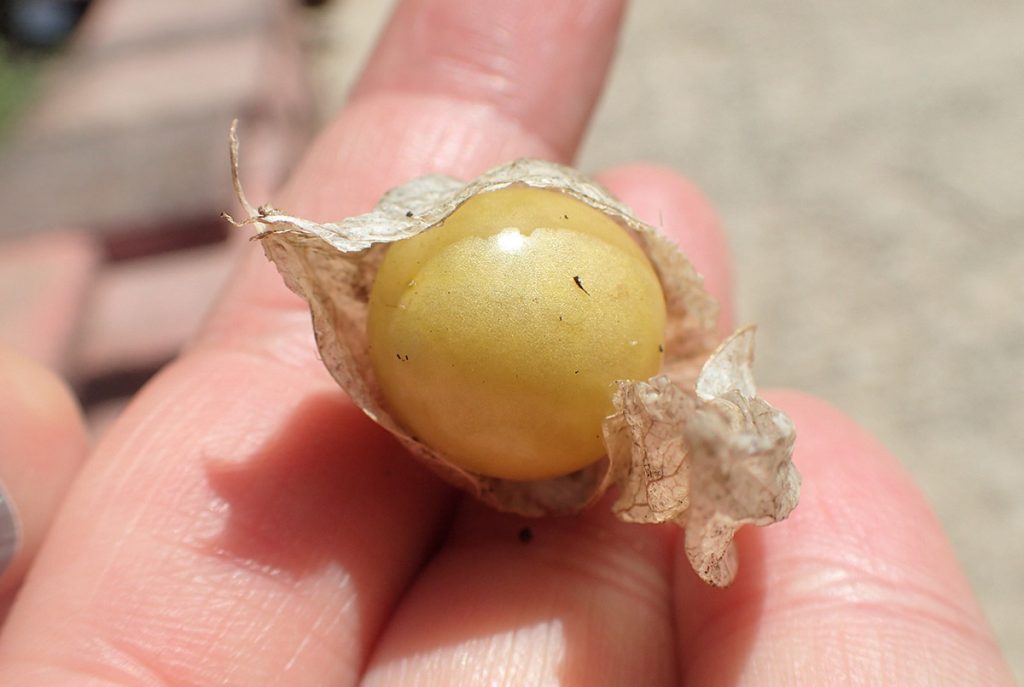
Mysterious morning glory
Another weed I’ve found is this morning glory vine:
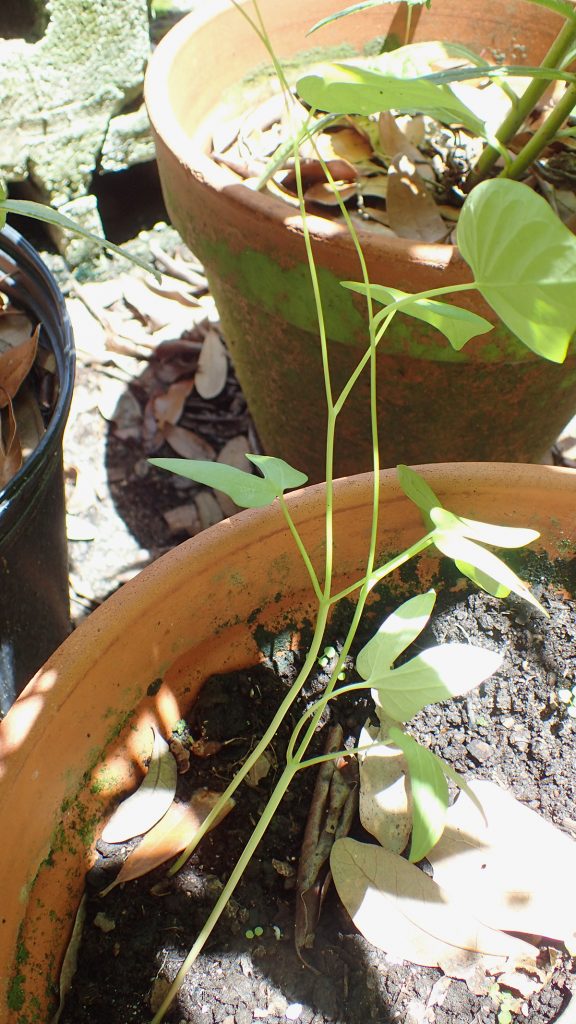
This volunteered in a pot and soon attached itself to the ironweed in the neighboring pot. I wanted to let this grow a little, as we do have native morning glory vines in Florida. Looking more closely at the different species in our area, I think I know what it might be, and whether it’s native is a matter of debate.
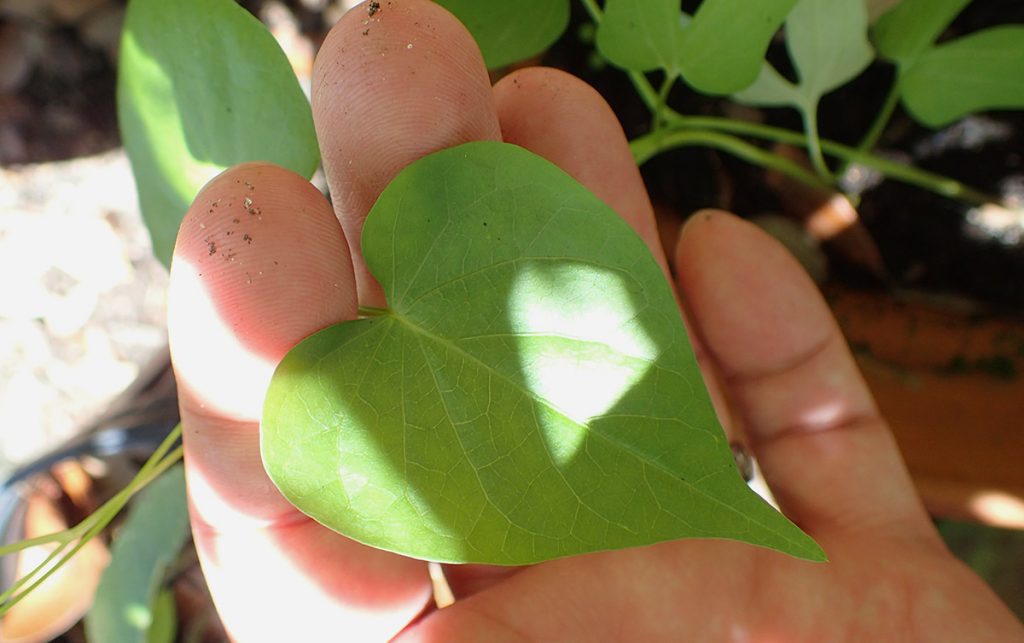
A couple of species of morning glory have heart shaped leaves, including ocean blue morning glory. That happens to be the type of morning glory growing across the street, which makes it a likely candidate. This is one of those tricky plants we encounter when we go to Google them. Some sites say it’s native, others that it’s introduced. Some species have become so ingrained in the US that the USDA starts to recognize them as native.
Many of these types of plants are native to the tropics, and make their way up here anthropogenically. Might this plant have benefits? It might. And then, as our climate warms, wouldn’t it make sense that this plant might outcompete less heat tolerant natives? Anyhow, I’m close to pulling it. As much as I like to treat the yard as an experimental space sometimes, I don’t like the way it’s wrapped around the ironweed.
And lastly…
I’ve seen a lot of little baby lizards running around the yard. ‘Tis the (mating) season, it seems:
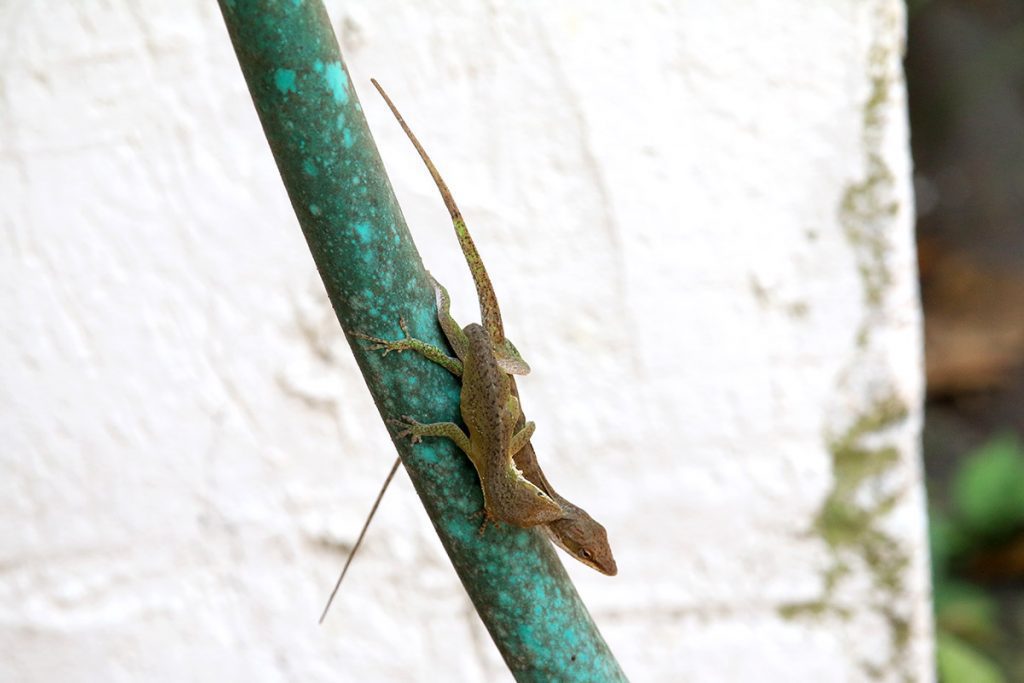
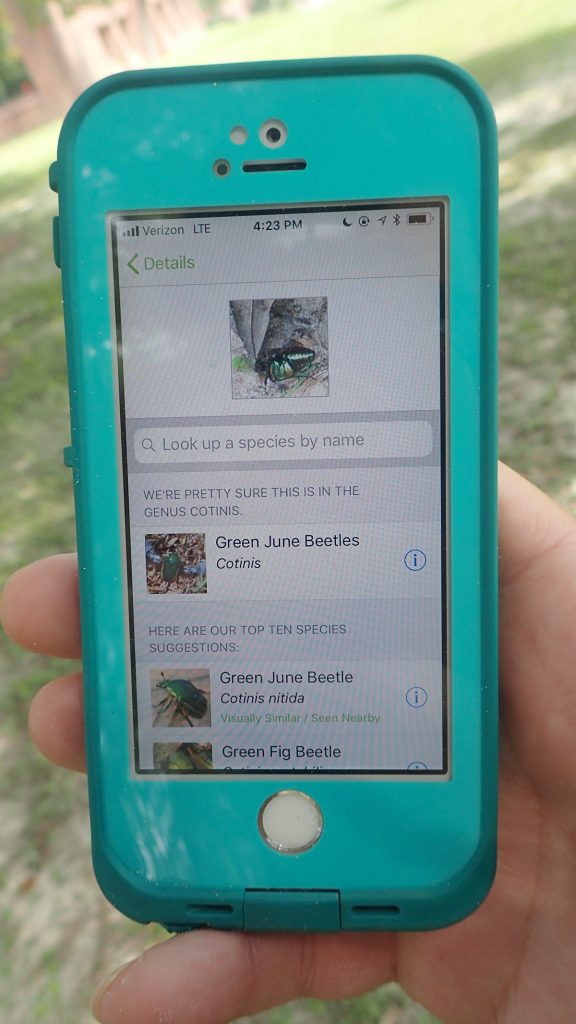
Apps and Citizen Science mentioned in the Backyard Blog
iNaturalist
Identify plants, animals, lichens, and fungi in your yard. Other users correct your identifications if you’re wrong, and even if they don’t, it can be a good springboard to further research.
Seek by iNaturalist
Instant identification, and it doesn’t record your location. This is a good option for kids with phones.
Monarch Larva Monitoring Project
Enter information about monarch caterpillars in your yard, and help researchers get a sense of the health of the monarch population that year, and how and when they’re migrating.
Great Sunflower Project
Record the number of pollinators visiting your flowers, and help researchers map pollinator activity across the country.
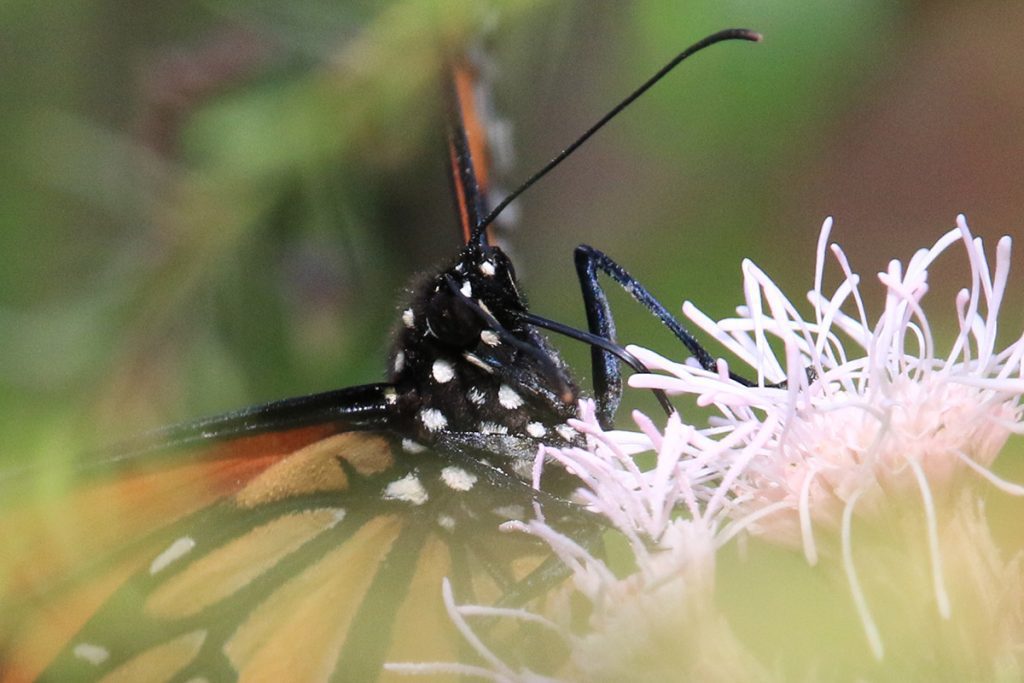
Dig Deeper into Backyard Ecology
What can we do to invite butterflies, birds, and other wildlife into our yards? And what about the flora and fauna that makes its way into our yards; the weeds, insects, and other critters that create the home ecosystem? WFSU Ecology Blog takes a closer look.


